| ||
| ||
| ||
| ||
| ||
| ||
|
OpenSwitch
Description: OpenSS7 Application Design Documentation.
The OpenSwitch product provides an Open Source SoftSwitch. A SoftSwitch is a device which provides call control for both traditional and next generation network technologies based on open signalling and communciations protocols. This product leverages on some of the enabling products listed above. This product focuses on the ISUP, SCCP and TCAP capabilities of the OpenSS7 stack. It utilizes M3UA, SUA and TUA for redunancy and reliability and supports TALI integration to Tekelec IP7 and other TALI compliant products.
A PDF version of this document is available here.
OpenSS7 VoIP Switch
OpenSS7 VoIP Switch High-Level Design and Project Plan
About This Manual
This is Edition 7.20141001, last updated 2014-10-25, of The OpenSS7 VoIP Switch High-Level Design and Project Plan, for Version 1.1 release 7.20141001 of the OpenSS7 package.
Executive Overview
This document provides a High-Level Design and Project Plan for the OpenSS7 VoIP Switch. The initial and primary purposes of this equipment is to provide a scalable, carrier-grade platform for interconnecting VoIP backbone networks to the PSTN using SS7.
The OpenSS7 Project
The OpenSS7 Project is an open source software project that has developed many protocol components within the SS7, SIGTRAN, ISDN and VoIP protocol stacks. Intellectual property rights for the OpenSS7 Project are held by OpenSS7 Corporation. All OpenSS7 Project software is eventually licensed under the GNU Affero General Public License. OpenSS7 Corporation also provide commercial licensing of OpenSS7 Project software under terms less restrictive than the AGPL.
The OpenSS7 VoIP Switch
OpenSS7 can provide VoIP gateway capabilities in a high-performance, low-cost, small-footprint platform leaveraging the GNU/Linux operating system distributions and tools, and utilizing low-cost commodity, or high-quality standardized hardware.
For details on platform applications, see Application Architecture, Network Architecture, Optional Application Support, and Optional Network Support.
Open Source Software
The OpenSS7 Project leverages the widespread use of GNU/Linux operation systems, distributions, and FSF tools such as ‘autoconf’ and RPM. For example, this document was formatted for PDF, HTML, info and plain text using the GNU texinfo system, ‘autoconf’, and the TeX formatting system.
The open source model avoids proprietary lock-in and permits in-house or outsourced development. All source code is available for use and modification by the end customer. All build tools, documentation and associated resources are generally available. The availability of the source code and complete documentation eases problem resolution and can offer upgrades and fixes even in advance of client problem reports.
For details on software solutions, see Protocol Architecture, Software Architecture, Optional Protocol Support, and Optional Software Support.
Commodity Hardware
By best utilizing commodity PC or standardized CompactPCI hardware, OpenSS7 makes available the highest performance platforms available on the market at back-to-school prices. When carrier-grade and large scale is not essential, 3GHz Pentium class servers in hardened rack mount chassis can be used at a fraction of the cost, and yet outperform, other solutions. Where carrier-grade is necessary, embedded Linux on standardized PICMG 2.16 NEBS compliant chassis make for a higher cost, but more reliable alternative.
For details on hardware solutions, see Platform Architecture, Hardware Architecture, and Optional Hardware Support.
Rapid Development
The OpenSS7 Project has already developed protocol components completing the SS7 and SIGTRAN signalling stacks including MTP Level 2 and Level 3, ISUP, SCCP, TCAP; and SCTP, M2PA, M2UA, M3UA, SUA and TUA. Development of a VoIP Switch to meet initial field requirements needs only the development of some intermediate and auxillary modules.
For details on scheduling, see Logistics.
An Evolving Solution
The OpenSS7 Project is evolving to support more protocol stacks including ISDN and VoIP. Support for an ever expanding capability is demonstrated by the additional options available as described in Optional Application Support, Optional Network Support, Optional Protocol Support, Optional Software Support, and Optional Hardware Support.
Conclusions
In summary, an OpenSS7 VoIP Switch an excellent application of the OpenSS7 SS7 and VoIP stacks and can be provided at a affordable price on short time-lines, while offering an evolution path for future deployment applications.
Brian Bidulock The OpenSS7 Project
Executive Summary
The overarching objective of this project is replacing Excel’s existing Veraz Softswitches with an opensource replacement on rapid timelines in Excel’s existing network. This is a high-risk development project with many development challenges that must be closely managed to be successful. The project is suitable for a time-boxing approach.
Under time-boxing, development gaps and deliverables are placed on a matrix with two axes which reflect increasing client need and increasing development effort. Then the deliverables which are most needed by the client and which require the least effort are attempted first, followed by lower needs and more effort, at last completed with the least need and the most effort.
While intended to be an iterative and refined process, the current time-boxing is as follows:
- Demonstrate M3UA interoperability with the Tekelec Eagle in a redundant configuration.
- Demonstrate interoperability with Excel’s LNP LSCP (via the Tekelec Eagles using M3UA) by dipping the database for various numbers.
- Demonstrate interoperability with the Veraz, Cisco and Sonus Media Gateways1 by performing basic circuit connections, tone generation and detection using MEGACO/H.248 binary format over UDP per MSF per MSF-IA-MEGACO.003.01-FINAL.
- Demonstrate ISUP interoperability with the DMS-250 by performing Q.784/Telcordia interoperability testing. Perform call connections between DSM-250’s utilizing a media gateway.
- Demonstrate ISUP to SIP and SIP to ISUP call handling via a Media Gateway.
- Demonstrate Application Server interaction (call-by-call control) and successful routing operation and billing generation.
- Demonstrate high-capacity call handling and redundant fail-over.
Preface
Document Information
Abstract
This document provides a High-Level Design and Project Plan for the OpenSS7 VoIP Switch.
Objective
The objective of this document is to provide a High-Level Design and Project Plan for the development of a low cost, high-performance, VoIP Switch using OpenSS7 SS7 stack components, software, and compatible systems and hardware.
Intent
The intent of this document is to act as a High-Level Design and Project Plan for a project for an OpenSS7 VoIP Switch. As a High-Level Design and Project Plan, this document discusses components and systems which are not necessarily complete. OpenSS7 Corporation is under no obligation to provide any software, system or feature listed herein.
Audience
This document is intended for a technical audience. The reader should be familiar with most ETSI, ITU-T and ANSI, Signalling System No. 7 recommendations, H.323, H.225, H.245, as well as IETF drafts and RFCS for RTP, SIP, SIP-T, MEGACO, MGCP, and SIGTRAN protocols.
Revisions
Take care that you are working with a current version of this document: you will not be notified of updates. To ensure that you are working with a current version, contact the Author, or check The OpenSS7 Project website for a current version.
Version Control
$Log: voip.texi,v $ Revision 1.1.2.3 2011-08-07 11:14:36 brian - mostly mandriva and ubuntu build updates Revision 1.1.2.2 2011-07-27 07:52:17 brian - work to support Mageia/Mandriva compressed kernel modules and URPMI repo Revision 1.1.2.1 2009-06-21 10:50:50 brian - added files to new distro
ISO 9000 Compliance
Only the TeX, texinfo, or roff source for this document is controlled. An opaque (printed or postscript) version of this document is an UNCONTROLLED VERSION.
Disclaimer
OpenSS7 Corporation disclaims all warranties with regard to this documentation including all implied warranties of merchantability, fitness for a particular purpose, non-infringement, or title; that the contents of the document are suitable for any purpose, or that the implementation of such contents will not infringe on any third party patents, copyrights, trademarks or other rights.. In no event shall OpenSS7 Corporation be liable for any direct, indirect, special or consequential damages or any damages whatsoever resulting from loss of use, data or profits, whether in an action of contract, negligence or other tortious action, arising out of or in connection with any use of this document or the performance or implementation of the contents thereof.
OpenSS7 Corporation reserves the right to revise this software and documentation for any reason, including but not limited to, conformity with standards promulgated by various agencies, utilization of advances in the state of the technical arts, or the reflection of changes in the design of any techniques, or procedures embodied, described, or referred to herein. OpenSS7 Corporation is under no obligation to provide any feature listed herein.
Document Organization
This document is organized as follows:
- Introduction
Introduction to the OpenSS7 VoIP Switch application.
- Application Architecture
The application requirements and architecture.
- Network Architecture
The network architecture for the application.
- Reference Architecture
The reference architecture for the application.
- System Architecture
The architecture of the OpenSS7 VoIP Switch system.
- Platform Architecture
The architecture of the OpenSS7 VoIP Switch platform.
- Protocol Architecture
The protocol architecture supporting the application.
- Software Architecture
The software architecture supporting the protocol stack and application.
- Hardware Architecture
The hardware architecture supporting the protocol stack and application.
- Logistics
Project logistics for completion of the VoIP Switch application.
- Optional Application Support
Additional application support not directly contributing to the current objective.
- Optional Network Support
Additional network interface support not directly contributing to the current objective.
- Optional Protocol Support
Additional protocol component support not directly contributing to the current objective.
- Optional Software Support
Additional software support not directly contributing to the current objective.
- Optional Hardware Support
Additional hardware support not directly contributing to the current objective.
- Programmatic Interfaces
Programmatic interfaces to selected protocol components.
- Platform Sizing
Detailed platform sizing considerations.
- Index
Index of concepts.
1 Introduction
This document provides a High-Level Design and Project Plan for a platform to provide scalable OpenSS7 VoIP Switch capabilities. The primary driver for the OpenSS7 VoIP Switch is to provide a system capable of interconnecting a VoIP backbone to the PSTN using SS7. This document provide a high-level design and proposal for a production system to provide this capability at a number of scale points.
The proposal utilizes, where possible, existing OpenSS7 SS7, SIGTRAN and VoIP stack components and provides a development plan for components that are specific to the OpenSS7 VoIP Switch initial requirements.
This document discusses the resulting software configuration that will be put in place on the production system, the platform configuration for the production system, and a network configuration for deployment. Also discussed is an overview of the project management logistics for successful completion over the course of this development project.
It is intended that the document be a “living” document, that is updated over the course of this development project.
1.1 The OpenSS7 VoIP Switch
This project provides an OpenSS7 VoIP Switch platform that provides interconnection to the PSTN using SS7 ISUP trunks and is capable of routing calls to and from the PSTN and a VoIP backbone network using SIP, SIP-T, H.323 or BICC signalling and controlling Media Gateways utilizing RTP transport using MEGACO/H.248.
1.2 Project Drivers
The lead purpose of the OpenSS7 VoIP Switch is to provide PTSN interconnection to an existing VoIP backbone and deployment infrastructure using a fully opensource solution.
1.3 Scope
Because of early deployment drivers, requirements for scale, yet a focus on opensource software, the OpenSS7 VoIP Switch platform is constructed using standardized COTS (Commodity Off The Shelf) hardware in a NEBS 3/ETSI compatible chassis providing cost effective servicability and reliability. Carrier-grade serviciability and reliability utilizing standardized PICMG 2.16 or AdvancedTCA telephony hardware in a a NEBS 3/ETSI compliant chassis for more hardenned installations remains possible.
1.3.1 Objectives and Milestones
The project lays out the following objectives, in no particular order:
- Establish interoperability with the Veraz Media Gateway. It is intended that the Veraz Media Gateway be controlled using MEGACO/H.248 Version 2 binary format over UDP or SCTP per MSF-IA-MEGACO.003.01-FINAL. Successful interoperability will be demonstrated by successfully connecting basic calls at the local and access tandem level on SS7 IMTs.
- Establish interoperability with the Cisco Gateway. It is intended that the Cisco Media Gateway be controlled using MEGACO/H.248 Version 2 binary format over UDP or SCTP per MSF-IA-MEGACO.003.01-FINAL. Successful interoperability will be demonstrated by successfully connecting basic calls at the local and access tandem level on SS7 IMTs.
- Establish interoperability with the Sonus Media Gateway. It is intended that the Sonus Media Gateway be controlled using MEGACO/H.248 Version 2 binary format over UDP or SCTP per MSF-IA-MEGACO.003.01-FINAL. Successful interoperability will be demonstrated by successfully connecting basic calls at the local and access tandem level on SS7 IMTs.
- Establish interoperability with the Tekelec Eagle M3UA implementation. It is intended that the Tekelec Eagle be interconnected using RFC 3332, RFC 4666 or ETSI TS 102 142 M3UA using RFC 2960, RFC 4460 or ETSI TS 102 141 SCTP. Successful interoperability will be demonstrated by successfully exchanging ISUP and LNP/TCAP signalling via the STP.
- Establish interoperability with a DMS-250. It is intended that the DMS-250 be interconnected using ANSI ISUP. Sucessful interoperability will be demonstrated by successfully connecting basic calls at the local and access tandem level on SS7 IMTs.
- Establish interoperability with an (unidentified vendor) LNP LSCP. It is intended that the LSCTP be interconnected using ANSI TCAP. Successful interoperablity will be demonstrated by successfully dipping the LNP database.
- Establish interoperatbiliy with an Application Server peforming call-by-call control, the design and
implementation to be provided by Excel.
It is currently intended that SPIRITS or INAP or AIN be used by the Application Server (SCP) to
control the OpenSS7 VoIP Switch running an AIN/INAP call model.
Successful interoperability will be demonstrated by successfully connecting basic calls at the local
and access tandem level on SS7 IMTs, including:
- Connect ISUP to ISUP calls across Excel’s network.
- Connect ISUP to SIP calls across Excel’s network.
- Connect SIP to ISUP calls across Excel’s network.
- Connect SIP to SIP calls across Excel’s network.
- Demonstrate high levels of call handling capability (over 250 calls per second) in the laboratory.
- Demonstrate high levels of call handling capability under failover scenarios in the laboratory.
1.3.2 Phases and Timeboxing
The longer term project is broken into the following phases:
- Phase 1 2
The initial phase of the project is intended to provide the capabilities of the OpenSS7 VoIP Switch for PSTN to VoIP backbone tandem for H.323.
- Phase 2
The second phase of the project adds tandem gateway capabilities for SIP-T.
- Phase 3
The third phase of the project adds network service capabilities.
- Phase 4
The fourth phase of the project adds softswitch capabilities.
- Phase 5
The fifth phase of the project completes a VoIP (NGN) switch.
Although some reference is made to capabilities supporting other phases, Phase 1 and Phase 2 are the focus of this document.
1.3.3 Gates
Each phase of the project consists of seven gates. The seven gates are defined as follows:
- Gate 0 — Concept
-
Gate 0 is passed when the initial concept has been elucidated and work is begun on a High-Level Design. This is an internal OpenSS7 gate.
- Gate 1 — High-Level Design
-
Gate 1 is passed when the high-level design has been reviewed to the satisfaction of the consumers of the project. This is an external review gate. OpenSS7 internally passes this gate once the High-Level Design has been published and work is begun on a detailed design. 3
- Gate 2 — Detailed Design
-
Gate 2 is passed when the detailed design has been reviewed to the satisfaction of the consumers of the project and the developers on the project. This is an external as well as an internal review gate. OpenSS7 passes this gate once the Detailed Design has been published and work base begin on development and implementation of the design. 4 Passing this gate moves from the design stage to the development stage of the project.
- Gate 3 — Development and Implementation
-
Gate 3 is passed when the software and systems development and implementation to the detailed design is complete and testing has begun. This is an internal review gate. OpenSS7 internally passes this gate when software is code complete and hardware has been installed for testing.
- Gate 4 — System Test
-
Gate 4 is passed once the product implementation meets all internal ad hoc and formal conformance test suites and internal testing is complete. This is an internal review gate. OpenSS7 passes this gate internally once conformance testing is complete. Passing this gate moves from the development stage to the support stage of the project.
- Gate 5 — Acceptance Test
-
Gate 5 is passed once the product implementation has passed external Gamma client acceptance testing. This is an external review gate. OpenSS7 passes this gate internally once participation in external acceptance testing is complete.
- Gate 6 — Project Complete
-
Gate 6 is passed once all support obligations for the product implementation have been discharged. This is an internal review gate. OpenSS7 passes this gate once support agreements have terminated.
For more details on Gate scheduling for Phase 1 and Phase 2 of the VoIP Switch project, see Schedule.
2 Application Architecture
The OpenSS7 VoIP Switch is intended to provide high performance and high density PSTN to VoIP backbone gateway adding SS7 interconnection capability to an existing or back-end VoIP network.
2.1 Application Requirements
Application requirements have been broken into 5 phases using the timeboxing approach.
2.1.1 Phase 1 Requirements
Phase 1 requirements provide a VoIP gateway capability that will connect an existing H.323 VoIP network to the PSTN using SS7 ISUP trunks.
- — Integral Media Gateway for RTP/RTCP to G.703/G.704 G.711 A- and mu-law.
- — Integral Signalling Gateway for SS7 ISUP and SS7 TCAP.
- — Local Number Portability.
- — Lawful Intercept.
- — Integral Media Gateway Controller for H.323
- — Integral Back End functions for H.323.
- — Integral H.323 Gatekeeper.
2.1.2 Phase 2 Requirements
Phase 2 requirements provide SIP-T capabilities.
- — Integral Media Gateway Controller for SIP-T.
- — Integral Back End functions for SIP-T.
- — Integral SIP redirect/proxy server.
2.1.3 Phase 3 Requirements
Phase 3 requirements provide network service capabilities.
- — ENUM support.
- — AAA support.
- — EAP authentication.
- — External PLMN authentication.
- — GSM MSC/VLR capabilities.
- — ETSI Tiphon 4 interworking.
- — ISDN support on E interface.
2.1.4 Phase 4 Requirements
Phase 4 requirements expose internal interfaces to provide softswitch capabilities.
- — J Interface (SIGTRAN) exposed.
- — N Interface (MGCP, H.248/MEGACO) exposed.
2.1.5 Phase 5 Requirements
Phase 5 requirements complete full VoIP (NGN) switching.
- — Support for directly attached H.323, SIP and MGCP IP Phone terminals.
- — Full RAS support for internal H.323 gatekeeper and SIP proxy server.
- — Full class 5 residential/business feature set.
2.2 Solution Architecture
Although the functions of Media Gateway Controller, Media Gateway and Signalling Gateway have been decomposed, and in the past these functional groups have been implemented on separate physical platforms, modern compute capacity and densities permit these functions to be integrated into a single phyical platform without limitation. Open standard interfaces are utilized internal to the platform to permit a decomposed model to be split out and to permit ETSI Tiphon Version 4 compatibility.
2.2.1 OpenSS7 VoIP Switch for Deployment
In light of the foregoing, the solution architecture takes the form of an integrated VoIP switch capability of providing a number of functional groups in the traditional models. The OpenSS7 VoIP Switch integrates the following functional groups while still permitting standard interfaces to be exposed for maximum deployment flexibility:
- — Integral Media Gateway Controller for H.323 and SIP-T.
- — Integral Media Gateway for RTP/RTCP to PDH G.703/704 G.711 conversion.
- — Integral Signalling Gateway for SS7 ISUP, TCAP and ISDN signalling conversion.
- — Integral Gatekeeper for H.323 and redirect/proxy server for SIP-T.
2.3 Call Flows
This section provides some illustrative application call flows:5
3 Network Architecture
Figure 1 illustrates the network configuration for the OpenSS7 VoIP Switch in a deployment scenario. The gateway device is positioned and attached to the SS7 network (PSTN) and the IP network (VoIP).
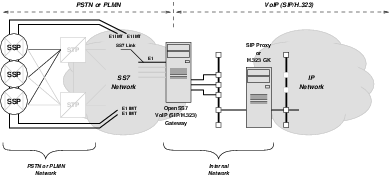
The VoIP Switch device is positioned between the SS7 network and the IP network providing VoIP communications.
The device is attached to the telephone network with two-way SS7 Inter Machine Trunks (IMTs) and SS7 signalling links. SS7 signalling links may be either A-links to STPs in the SS7 network, or F-links directly to interconnect SS7 switching offices within the telephone network. SSPs within the telephone network to which the devices is interconnected would have to be configured to deliver calls for the device to SS7 ISUP trunks interconnected to the device. For the purposes of the telephone network, the VoIP Switch would appear as a National intermediate office, but could also act as an International intermediate office or International incoming or outgoing office. Configuration as a National originating or terminating office is also possible. Full continuity testing, blocking and management of ISUP circuits is provided for by the OpenSS7 ISUP protocol module.
The device is attached to the SS7 utilizing CPC-388 or lesser grade OpenSS7 SS7 link and media channel TDM interface cards, 6 terminating SS7 A-links or F-links, either 64kbps Q.703 links or full span Q.703 Annex B 2.048Mbps high-speed links, or via a signalling gateway device terminating SS7 Level 2, 3 or 4 and transporting M2UA or M3UA back-haul signalling to the gateway device over SCTP.
The device is configured to perform routing of calls incoming from the telephone network based on ENUM lookups and INAP/SPIRITS triggers to RTP streams controlled by SIP or H.323 within the OpenSS7 complex. 7 The device is also responsible for switching and converting 64kbps digital paths from the IMTs terminated on the telephone network side to RTP media streams (using any encoding) on the OpenSS7 complex side. Full interworking of echo suppression/silence detection/comfort tone between ISUP and RTP will be performed. This switching is performed using the OpenSS7 internal Media Switch (MG) switching which provides for non-blocking switching of voice channels across TE410, CPC 384 or CPC 388 devices in the platform, as well as switching and conversion between RTP streams on dual Ethernet rails.
On the OpenSS7 complex side of the device, calls are connected to RTP streams on attached Ethernet and routed using the Client IP network. The VoIP Switch will act as a SIP proxy and H.323 Gatekeeper querying on-board or off-board ENUM DNS servers, and performing SIP/H.323 signalling to clients or other proxy/gatekeepers across the IP network. It could also be capable of INAP SSP/IP operation as well as a SPIRITS.
Calls outgoing from the OpenSS7 complex to the telephone network will be directed on the basis of subscription or by proxy/gatekeeper origination to the interconnected IMT trunks with or without number analysis.
Existing equipment may also be attached with ISDN PRI connections directly to the VoIP switch with the device acting in Network mode. This permits local PBX to be attached using ISDN. The VoIP switch would also be capable of BICC switching between VoIP switches as well as M2UA/M3UA distribution of signalling links and signalling points to permit a distributed and fully redundant IP architecture.
The telephone network side of the device signals using an ETSI ISUP Version 2 compliant National variant to the local interconnect controlling E1 facilities. The OpenSS7 side of the device signals using SIP-T or H.323 directly to SIP proxies or H.323 GK and terminal devices within the IP network. The device is also responsible for switching E1 voice channels into RTP streams.
The purpose of the VoIP Switch device is to provide SS7 ISUP access directly into the OpenSS7 VoIP environment, without the need for additional expensive or proprietary equipment.
On the VoIP network side of the device, the platform is connected on an internal LAN with multiple Ethernet segments and IP subnetworks through a Layer 2 switch to VoIP backbone routers. SIP calls originating within the VoIP network are accepted and responded to by the VoIP Switch application. Outgoing calls are tandemed to the PSTN over SS7 ISUP signalling and circuits. RTP channels are terminated on the gateway device and converted to 64kbps A-law ISUP TDM circuits.
From the viewpoint of the SS7 network, the gateway device acts as an SS7 SSP intermediate or originating/terminating switch with its own SS7 signalling point code. From the viewpoint of the VoIP network, the gateway device acts as SIP or H.323 gateway, or a BICC intermediate switch.
4 Reference Architecture
Figure 2 illustrates the VoIP Switch reference interfaces form the ETSI Tiphon model.
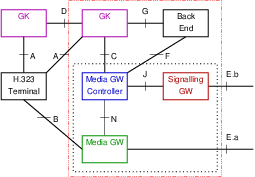
4.1 VoIP Switch Reference Entities
The following functional entities are used to decompose functions in the VoIP switch and network:
4.1.1 Terminal
The H.323 or SIP terminal support the A or B interface. The A interface is used for communicating with H.323 Gatekeepers or other H.323 Terminals, or SIP FS, PS or UAC.
Terminal devices are extenal to the VoIP Switch. In initial phases, terminal device interface (see see Reference Interface A) will only be supported via external H.323 Gatekeepers, SIP forwarding servers or SIP proxy servers. Terminal device attachment for H.323, SIP and H.248 terminals will be supported in later phases.
4.1.1.1 H.323 Terminal
4.1.1.2 SIP Terminal
4.1.1.3 H.248/MEGACO Terminal
4.1.2 Gatekeeper
The H.323 Gatekeeper, SIP forwarding server, or SIP proxy server, supports the A, C, D and G interfaces.
The VoIP Switch will support an internal Gatekeeper function that will initially support the D interface, and support the A interface in later phases. Initially the G and F interfaces will be internal to the platform, and will be exposed in later phases.
4.1.3 Media Gateway Controller
The H.323 or SIP Media Gateway Controller supports the C, F, J and N interfaces.
The VoIP Switch will incorporate an integral Media Gateway Controller function. In initial phases, the C, F, J and N interfaces will be internal to the platform. In subsequent phases, these interfaces will be exposed.
4.1.3.1 H.323 MGC
4.1.3.2 SIP MGC
The SIP Media Gateway Controller is primarily responsible for conversion of SCN signalling from the PSTN on the J Interface to VoIP signalling to the H.323 Gatekeeper or SIP redirect/proxy server on the C Interface. Also, the SIP MGC must coordinate this conversion with the control of media conversion from G.703/704 G.711 A- and mu-law circuits from the PSTN to RTP/RTCP channels within the VoIP network.
Conversion between SS7 ISUP signalling and SIP-T signalling is described in
4.1.4 Media Gateway
The Media Gateway supports the N and B interfaces.
The VoIP Switch will incorporate an integral Media Gateway function. In initial phases, the N interface will be internal to the platform. In subsequent phases, the N interface will be exposed.
The current document is concerned with media gateway functionality for media gateways supporting SS7 ISUP trunks (G.703/704) and ISDN PRI trunks (G.703/704).
4.1.5 Signalling Gateway
The Signalling Gateway supports the J and E.b interfaces.
The VoIP Switch will incorporate an integral Signalling Gateway function. In initial phases, the J interface will be internal to the platform. In subsequent phases, the J interface will be exposed.
The current document is concerned with signalling gateway functionality for SS7 ISUP, SS7 TCAP, and ISDN Q.931/921 signalling.
4.1.6 Back End
The back end supports the F and G interfaces.
The VoIP switch will incorporate an integral Back End function. In initial phases, the F and G interfaces will be internal to the platform. In subsequent phases, the F and G interfaces will be exposed.
The current document is concerned about operational support systems, bulling systems, and service menagement systems. I addition, database services (AIN/SPIRITS/etc) are considerered at this interface.
4.2 VoIP Switch Reference Interfaces
4.2.1 Reference Interface A
This is the interface of the H.323 Terminal or SIP Terminal to the H.323 Gate Keeper or SIP Proxy.
Figure 3 illustrates the protocols at the A Interface.
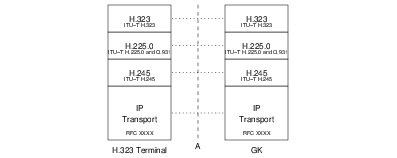
4.2.1.1 Interface A — H.323
Figure 3a illustrates the use of H.323 based protocols at the A Interface.
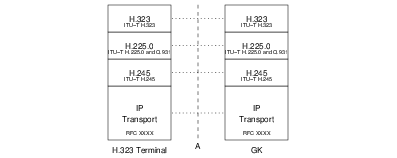
Protocols at this interface for H.323 operation include:
- — H.323
- — H.225.0
- — Q.931
- — H.245
- — TCP
- — SCTP
4.2.1.2 Interface A — SIP
Figure 3b illustrates the use of SIP based protocols at the A Interface.
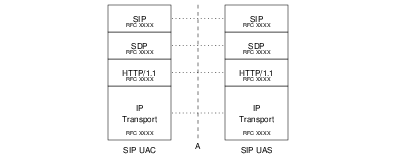
Protocols at this interface for SIP operation include:
- — SIP (UAC–UAS)
- — SDP
- — HTTP/1.1
- — TCP
- — SCTP
In initial phases of the VoIP Switch project, the A interface will not be directly supported. The A Interface will be suppored in later phases of the project.
4.2.2 Reference Interface B
This is the interface of the Terminal to the Media Gateway.
Protocols at this interface include:
- — RTP/RTCP
- — UDP
- — IP
4.2.3 Reference Interface C
This is the interface of the Media Gateway Controller to the H.323 Gate Keeper or SIP Proxy.
Figure 5 illustrates the protocols at the C Interface.
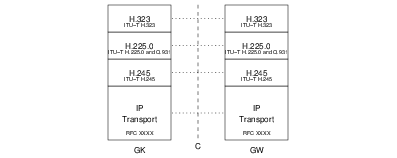
In initial phases of the VoIP Switch project, the C interface will be internal to the platform. The C Interface will be exposed in later phases of the project.
4.2.3.1 Interface C — H.323
Figure 5a illustrates the protocols supporting H.323 at the C Interface.
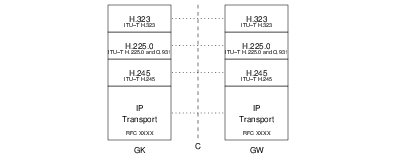
Protocols at this interface for H.323 operation include:
- — H.323
- — H.225.0
- — Q.931
- — H.245
- — TCP
- — SCTP
4.2.3.2 Interface C — SIP
Figure 5b illustrates the protocols supporting SIP-T at the C Interface.

Protocols at this interface for SIP operation include:
- — SIP (SIP-T)
- — SDP (ISUP)
- — HTTP/1.1
- — TCP
- — SCTP
4.2.3.3 Interface C — BICC
Protocols at this interface for BICC operation include:
- — BICC
- — TCP
- — SCTP
4.2.4 Reference Interface D
This is the interface of the H.323 Gate Keeper or SIP Proxy to the H.323 Gate Keeper or SIP Proxy.
Figure 6 illustrates the protocols at the D Interface.
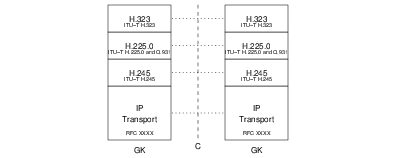
4.2.4.1 Interface D — H.323
Figure 6a illustrates the protocols supporting H.323 at the D Interface.
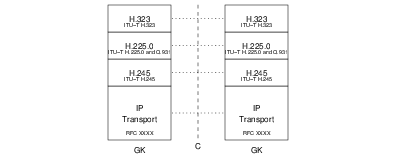
Protocols at this interface for H.323 operation include:
- — H.323
- — H.225.0
- — H.245
- — TCP
- — SCTP
4.2.4.2 Interface D — SIP
Figure 6b illustrates the protocols supporting SIPT at the D Interface.
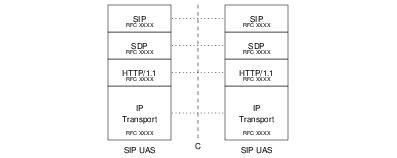
Protocols at this interface for SIP operation include:
- — SIP (SIP-T)
- — SDP
- — HTTP/1.1
- — TCP
- — SCTP
4.2.4.3 Interface D — BICC
Protocols at this interface for BICC operation include:
- — BICC
- — TCP
- — SCTP
4.2.5 Reference Interface E
This is the interface of the Gateway to the Switched Circuit Network. It consists of two interfaces: a signalling interfaces (E.b) and a circuit interface (E.a).
4.2.5.1 Reference Interface E.a
This is the circuit interface from the gateway to the switched circuit network.
Interface E.a — ATM
Protocols at this interface for ATM operation include:
- — ATM AAL2
- — ATM AAL3
Interface E.a — PDH
Protocols at this interface for PDH operation include:
- — G.703
- — G.704
4.2.5.2 Reference Interface E.b
This is the signalling interface from the gateway to the switched circuit network.
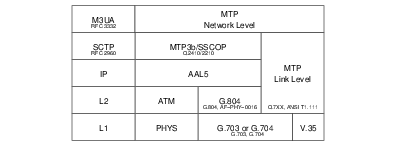
Interface E.b — SS7
Figure 8a illustrates protocols in support of SS7 signalling at the E.b Interface.
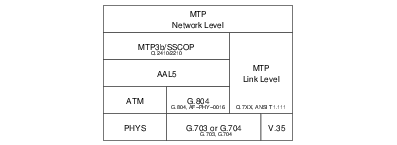
Protocols at this interface for SS7 operation include:
- — TCAP
- — SCCP
- — ISUP
- — SS7-MTP
Interface E.b — ISDN
illustrates protocols in support of ISDN signalling at the E.b Interface.
Protocols at this interface for ISDN operation include:
- — ISDN Q.931
- — ISDN Q.921
Interface E.b — ATM
Figure 8c illustrates protocols in support of ATM signalling at the E.b Interface.
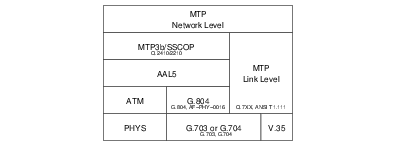
Protocols at this interface for ATM operation include:
- — B-ISUP
- — MTP3b
- — SSCOP
- — AAL5
4.2.6 Reference Interface F
This is the interface of the Media Gateway Controller to Back End OSS.
Protocols at this interface include:
- — ENUM
- — SPIRITS
- — AAA
4.2.7 Reference Interface G
This is the interface of the H.323 Gatekeeper or SIP Proxy to the back end OSS.
Protocols at this interface include:
- — ENUM
- — SPIRITS
- — AAA
In initial phases of the VoIP Switch, the G Interface will be internal to the platform. The G Interface will be exposed in later phases.
4.2.8 Reference Interface J
This is the interface of the Media Gateway Controller to the Signalling Gateway.
Figure 11 illustrates the protocols at the J Interface.

In initial phases of the VoIP Switch, the J interafe will be internal to the platform. The J Interface will be exposed in later phases.
4.2.8.1 Interface J – SS7
Figure 11a illustrates the protocols in support of SS7 signalling at the J Interface.
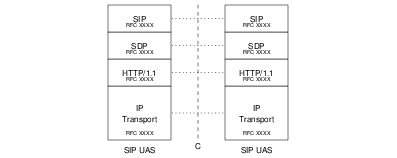
Protocols at this interface for SS7 operation include:
- — TUA
- — SUA
- — ISUA
- — M3UA
- — M2UA
- — M2PA
- — SCTP
- — TALI
- — TCP
4.2.8.2 Interface J – ISDN
Figure 11b illustrates the protocols in support of ISDN signalling at the J Interface.
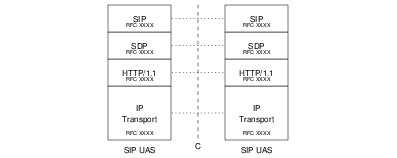
Protocols at this interface for ISDN operation include:
- — IUA
- — DUA
- — SCTP
4.2.8.3 Interface J – GR303/V5.2
Figure 11c illustrates the protocols in support of GR303/V5.2 signalling at the J Interface.
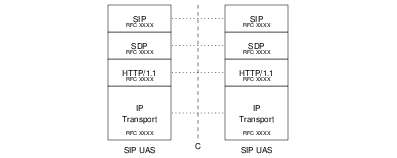
Protocols at this interface for GR303/V5.2 operation include:
- — V5UA
- — GR303UA
- — SCTP
4.2.9 Reference Interface N
This is the interface of the Media Gateway Controller to the Media Gateway.
Protocols at this interface include:
- — MGCP
- — H.248/MEGACO
- — TCP
- — SCTP
In initial phases of the VoIP Switch, the N interface will be internal to the platform. The N Interface will be exposed in later phases.
5 Protocol Architecture
illustrates the protocol configuration for the OpenSS7 VoIP Switch system. The protocol stack uses the following OpenSS7 stack components:
The following Protocol Stacks are provided as part of the OpenSS7 SS7 and VoIP stacks:
5.1 Applications
5.1.1 OpenSwitch Call Framework Application
The OpenSwitch Call Framework Application uses the OpenSwitch C++ call framework supporting Call Control Interface (CCI) based called control, Media Gateway Interface (MGI) based media switching and conversion, and Transaction Component Interface (TCI) based transactions. This is the module that performs call control, transaction services, and media switching conversion. This component is also responsible for triggers, digit translations, call and feature usage record generation, operational measurements, call and feature statistics and maintenance. To perform its functions it interfaces with ISUP, ISDN, BICC, SIP and H.323 signalling stacks using the published Call Control Interface (CCI), interfaces with the Media Gateway (MG) switching and conversion control stack using the published Media Gateway Interface (MGI), and interfaces with the transaction engine using the published Transaction Component Interface (TCI). Because the CCI, MGI and TCI are largely independent of the protocol stack providing call control signalling, the protocol stack providing media switchingconversion services, and the protocol stack providing transaction services, the OpenSwitch Call Framework application can be migrated to other ISUP and ISDN related protocols (e.g. BSSAP) and to other MG control protocols (e.g. MGCP or H.248) without significant impact on the OpenSwitch Call Framework.
5.2 SS7 Stack
SS7 stack components provide support for protocols in the protocol profile at the E.b Interface (see Reference Interface E.b). They provide Signalling Gateway (SG) function within the OpenSS7 VoIP Switch for support of SS7 SIGTRAN protocols at the J Interface, (see Reference Interface J). 8
5.2.1 ISUP/BICC/ISDN Operations Maintenance and Administration
The ISUP/BICC/ISDN OAM&P module is responsible for configuration of the SS7 and ISDN stacks, maintenance, statistics collection, operational measurements, management events and controls, log and alarm generation. This is a daemon process that is typically customized to meet a specific application.
5.2.2 Integrated Services Digital Network (ISDN) User Part (ISUP)
The ISUP driver performs the call functions necessary for switching calls under ISUP control. The driver is capable of acting in originating, intermediate and terminating switching roles in both the National and International networks. The driver provides interface to the OpenSwitch Call Framework application using the OpenSS7 Call Control Interface (CCI). This is the same interface that is used by the BICC, ISDN, SIP and H.323 drivers as well as OpenSS7 BSSAP, V5.2 and GR303 drivers.
The ISUP drvier supports all CCITT/ITU-T version (Blue Book forward), ETSI and ANSI versions (1992 forward), including circuit management. The ISUP driver provides a specialized Call Control Interface (CCI) to its users and accepts an Message Transfer Part Interface (MTPI) from below.
The ISUP driver is a STREAMS driver that runs in the Linux Kernel for maximum performance. The primary scale limiting characteristics of the ISUP drvier is the number of simultaneous calls and the rate of call attempts. Each simultaenous call requires state information and dynamic call information. Call identifier indexed hash tables must be appropriately sized and the mean and maximum simultaneous calls should be known for proper sizing.
The Integrated Services Digital Network (ISDN) User Part (ISUP) STREAMS driver is responsible for providing ISUP services on top of a Message Transfer Part (MTP) or MTP Level 3 User Adaptation Layer (M3UA) stream.
The OpenSS7 ISUP module supports all ISUP functions with the exception of performing actions on the bearer circuits. Actions on the bearer circuits are expected to be performed by the ISUP User utilizing the Media Gateway (MG) stack components.
Message Transfer Part (MTP) streams as linked beneath the ISUP module to provide MTP services to ISUP. Alternately, a SIGTRAN MTP Level 3 User Adatapation Layer (M3UA) or OpenSS7 STREAMS over SCTP stream may be linked.
The OpenSS7 ISUP driver contains all the necessary state machines, timers, circuit management and error handling as required by the ITU-T, ETSI and ANSI specifications.
This is an existing OpenSS7 SS7 stack component; for documentation, see: isup(4).
5.2.3 Transaction Capabilities Application Part (TCAP) Driver
The transaction capabilities application part driver performs the essential transaction functions of the SS7 signalling stack. SCCP or SUA streams are linked under the driver and the driver provides the functions of a TCAP SSP or SCP, MSC or HLR, SMSC and other TCAP nodes. Transaction Capabilities Application Part streams bound to INAP, MAP or LNP TCAP-SAPs are accessed by the transaction application using the Transaction Component Interface (TCI).

The TCAP driver supports all CCITT/ITU-T versions (Blue Book forward), ETSI and ANSI versions (1992 forward), including operation classes 1 through 5. The TCAP driver provides a specialized TR and TC interface to its users and accepts an X/Open NPI Revision 2.0 interface from beneath. In addition, a TPI Revision 2.0 user interface supporting an X/Open XNS 5.2 mOSI XTI library interface is provided.
The TCAP driver is a STREAMS driver that runs in the Linux kernel for maximum performance. The primary scale limiting characteristic of the TCAP driver is the number of simultaneous open transactions. Each open transaction requires a number of timers, state information and dynamic transaction information such as addressing. Transaction Identifier indexed hash tables must be appropriately sized and the mean and maximum simultaneous open transactions should be known for proper sizing.
The Transaction Capabilities Application Part (TCAP) STREAMS module is responsible for providing TCAP services on top of a Signalling Connection Control Part (SCCP) or SCCP-User Adaptation Layer (SUA) stream. In addition, it is possible to use an ISO/OSI Network Service Provider to provide the network services to TCAP.
The OpenSS7 TCAP component has message encoding and decoding for ITU-T/ETSI Application Context TCAP and ANSI Private TCAP. Interfaces provided to TCAP users include an XTI/mOSI capable TPI Version 2.0 interface, a Transaction Interface (TRI) as described in ITU-T Q.791, and a Component Interface (TCI) as also described in ITU-T Q.791. The ITU-T Q.791 TR and TC interfaces are support Java JTCAP.
Of these interfaces, the Transaction Interface (TRI) and Component Interface (TCI) are most efficient. This is because it is not necessary to open a new stream for each transaction as is the case with the TPI interface and the XTI/mOSI.
The OpenSS7 TCAP module supports all Operations Classes.
A SIGTRAN TCAP-User Adaptation Layer (TUA) or OpenSS7 STREAMS over SCTP multiplexing driver can be used between the TCAP and the TCAP-User to export the TCAP/TCAP-User interface between a provider and user host.
Signalling Connection Control Part (SCCP) streams are linked beneath the TCAP module to provide SCCP services to TCAP. Alternately, a SIGTRAN SCCP-User Adaptation Layer (SUA) or OpenSS7 STREAMS over SCTP stream may be linked.
The OpenSS7 TCAP module contains all the necessary state machines, timers, transaction error handling and component error handling as required by the ITU-T, ETSI and ANSI specifications.
This is an existing OpenSS7 SS7 stack component; for documentation, see: tcap(4).
5.2.4 Signalling Connection Control Part (SCCP) Driver
The signalling connection control part driver performs the essential transport functions of the SS7 signalling stack. Message Transfer Part or MTP3 User Adaptation Layer streams are linked under the driver and the driver provides the functions of a SCCP endpoint or relay with full global title translations. Signalling Connection Control Part streams bound to TCAP SCCP-SAPs are linked under the TCAP driver to form a complete SS7 stack in support of call transactions.

The SCCP driver supports all CCITT/ITU-T versions (Blue Book forward), ETSI and ANSI versions (1992 forward), including both connectionless and connection-oriented protocol classes 0 through 3. The SCCP driver provides an extended NPI Revision 2.0 interface to its users and accepts an NPI Version 2.0 (Connectionless) MTP interface from beneath or a specialized OpenSS7 MTPI interface. In addition, a TPI Revision 2.0 user interface supporting an X/Open XNS 5.2 XTI library interface is provided.
The SCCP driver also provide GTT streams for servicing Global Title Translations requests. These streams can be used by a user-space program for servicing GTT requests from a local or remote database, or can have specialized STREAMS modules pushed to perform rule-based GTT in the operating system kernel.
The SCCP driver is a STREAMS driver that runs in the Linux kernel for maximum performance.
The Signalling Connection Control Part (SCCP) STREAMS module is responsible for providing SCCP services on top of a Message Transfer Part (MTP) Level 3 (MTP3) or MTP3-User Adaptation Layer (M3UA) stream. In addition, it is possible to use an ISO/OSI connectionless Network Service Provider to provide the network services to SCCP.
The OpenSS7 SCCP component has message encoding and decoding for ITU-T/ETSI and ANSI SCCP. Interfaces provided to SCCP users include an XTI/OSI capable TPI Revision 2.0 interface, an NPI Revision 2.0 interface, and an SCCP-specific interface.
The OpenSS7 SCCP module supports all Protocol Classes.
This is an existing OpenSS7 SS7 stack component; for documentation, see: sccp(4).
5.2.5 Global Title Translations (GTT)
The Signalling Connection Control Part (SCCP) Global Title Translations (GTT) module is responsible for responding to SCCP-GTT translations originating from the SCCP module beneath and is responsible for generating outgoing SCCP-GTT translations to the SCCP module beneath. To perform its function, the SCCP-GTT indexes all information based on the SCCP Address, including dynamic (state) and provisioned (result) information. For performance in both a testing and production environment, the module provides three levels of database partitioning and caching:
- Rules
Rules can be provided that are used to determine provisioned information based on components of the index (GT). These rules can be used to generate a rather large simulated database without maintaining or accessing large database record areas. The rule base provides a simulated partitioned database. Each rule refers to a template or partial template of provisioned data.
- Templates
Templates can be provided that specify a profile of provisioned information for a class of indexes (GT). Templates provide a compact local in-kernel cache of templates. Indexes reference templates rather than complete records.
- Records
Records can be provided that specify the provisioned information for the specific index (GT). Records provide a local in-kernel cache of specified records. Records are unique for each index.
- Translations
The application can be queried by indicating the index (GT) and the module awaits a response containing the provisioned information. Translations provide access to an external database or algorithm.
For the OpenSS7 VoIP Switch, messages can be routed on Translation Type or on the basis of the Subsystem Number alone, resulting in a simple rule provided to the SCCP-GTT. If the OpenSS7 VoIP Switch application is not expected to perform in any other role, the OpenSS7 VoIP Switch application can bind as the "Default Destination" for all SCCP Unitdata messages, obviating the need for GTT.
This is an existing OpenSS7 SS7 stack component; for documentation, see: sccp(4).
5.2.6 Message Transfer Part (MTP)
The message transfer part driver performs the essential network functions of the SS7 signalling stack. Signalling link streams (see below) are linked under the driver and the driver provides the functions of a Signalling End Point (SEP) or Signalling Transfer Point (STP).
Message Transfer Part streams bound to ISUP MTP-SAPs are linked under the ISUP driver above to form a complete SS7 stack in support of call switching. 9
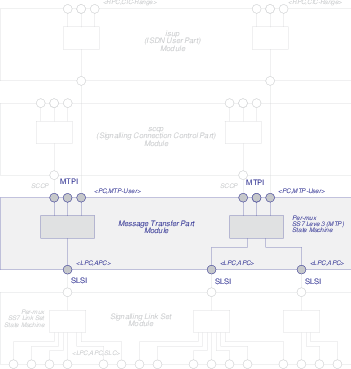
The MTP driver supports all CCITT/ITU-T versions (Blue Book forward), ETSI and ANSI versions (1992 forward), including full transfer function. The MTP driver provides a specialized MTP interface to its users, in addition to an NPI Revision 2.0 connectionless interface. A TPI Revision 2.0 (connectionless) user interface support X/Open XNS 5.2 XTI library functions is also provided.
The MTP driver is a STREAMS driver that runs in the Linux kernel for maximum performance.
The Message Transfer Part (MTP) Level 3 (MTP3) module is responsible for providing MTP services to its users.
The Message Transfer Part (MTP) Level 2 (MTP2) module is responsible for providing MTP services to its users.

These are an existing OpenSS7 SS7 stack components; for documentation, see: mtp(4).
5.2.7 Signalling Link (SL) Module
The signalling link module performs HDLC and SS7 Message Transfer Part Level 2 (Link) functions on a raw communications channel provided by the X400P driver and the E400P card. This module converts between the channel media stream (raw octet stream) and an SS7 signalling link signalling stream. These streams comprise SS7 signalling links and are linked under the MTP driver.
The signalling link module performs HDLC and SS7 Message Transfer Part Level 2 (Link) functions on a raw communications channel, such as that provided by the X400P driver and the E400P card. This module converts between the channel media stream (raw octet stream) and an SS7 signalling link signalling stream. These streams comprise SS7 signalling links and are linked under the MTP driver.
The SL module supports CCITT/ITU-T versions (Blue Book forward), ETSI and ANSI versions (1992 forward), including Q.703 and Q.703 Annex B (HSL) operation. TTC JQ.703 (1994) is also supported. The SL module provides a specialized SL interface to its users, in addition to an NCR Comten CDI Revision 2.0 Style 2 connectionless interface.
The SL module is a STREAMS module that runs in the Linux kernel for maximum performance.
The Signalling Link (SL) module is responsible for providing SL services to its users.

This is an existing OpenSS7 SS7 stack component; for documentation, see: sl(4).
5.2.8 Signalling Data Terminal (SDT) Module
The signalling data terminal module performs HDLC and lower level SS7 Message Transfer Part Level 2 (Link) functions including DAEDR, DAEDT, AERM, SUERM and SU Compression/Repetition on a raw communications channel or span, such as that provided by OpenSS7 Channel Drivers. This module converts between the raw channel media stream (raw octet stream) and an SS7 signalling data terminal stream. These streams comprise SS7 signalling data terminals and are pushed beneath the SL module.
The SDT module supports CCITT/ITU-T version (Blue Book forward), ETSI and ANSI versions (1992 forward), including Q.703 and Q.703 Annex B (HSL) operation. TTC JQ.703 (1994) is also supported. The SDT module provides a specialized SDT interface to its users, in addition to an NCR Comten CDI Revision 2.0 Style 2 connectionless interface.
The Signalling Data Terminal (SDT) module is responsible for providing SDT services to its users.
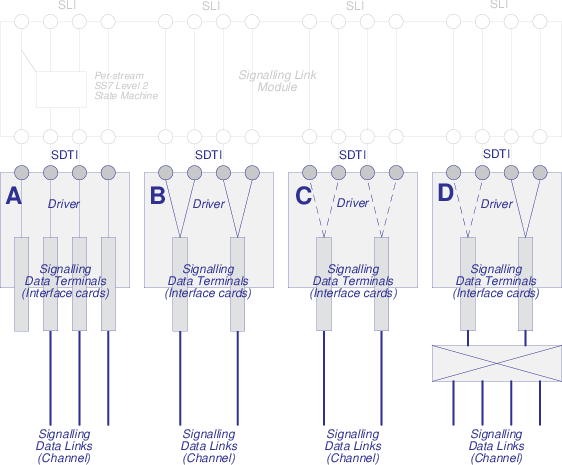
This is an existing OpenSS7 SS7 stack component; for documentation, see: sdt(4).
5.3 SIGTRAN Stack
SIGTRAN stack components provide support for protocols in the protocol profile at the J Interface, 10 in support of SS7, ISDN and GR303/V5.2 signalling protocols at E.b Interface. 11
5.3.1 SS7 User Adaptation Layers
SS7 User Adaptation Layers provide transport of SS7 signalling between the Media Gateway Controller and Signalling Gateway functions in the OpenSS7 VoIP Switch at the J Interface. 12 These protocols at the J Interface support SS7 signalling protocols at the E.b Interface. 13
5.3.1.1 ISUP User Adaptation Layer (ISUA)
This is an existing OpenSS7 SIGTRAN stack component; for documentation, see: isua(4).
5.3.1.2 TCAP User Adaptation Layer (TUA)
This is an existing OpenSS7 SIGTRAN stack component; for documentation, see: tua(4).
5.3.1.3 SCCP User Adaptation Layer (SUA)
The SUA driver provides the OpenSS7 VoIP Switch with the ability to act as an SUA AS (Application Server) in conjunction with an SUA SG (Signalling Gateway). In this project, the SG function is performed by existing lab equipment. The SUA driver accepts the transport of the SCCP to SCCP-User interface from the SG to the OpenSS7 VoIP Switch. The SUA driver links SCTP driver streams underneath it to provide the transport services for exporting the SCCP-User interface. The SUA driver provides the same interfaces to its users as the OpenSS7 SCCP.
The SUA driver is a STREAMS driver that runs in the Linux kernel for maximum performance.
This is an existing OpenSS7 SIGTRAN stack component; for documentation, see: sua(4).
5.3.1.4 MTP3 User Part Adaptation Layer (M3UA)
The M3UA provides transport of MTP3 User signalling between an MTP provider such as the OpenSS7 MTP driver and an MTP User such as the OpenSS7 ISUP driver. The M3UA driver links SCTP transport streams under the driver and provides for both ASP, SGP and combined ASP/SGP operation. The M3UA is used for redundancy and for distributing SS7 MTP3 across multiple hosts. The M3UA driver links SCTP driver streams underneath it to provide the transport services for exporting the MTP-User interface. The M3UA driver provides the same interface to its users as the OpenSS7 MTP.
The M3UA driver is a STREAMS driver that runs in the Linux kernel for maximum performance.
This is an existing OpenSS7 SIGTRAN stack component; for documentation, see: m3ua(4).
5.3.1.5 MTP2 User Part Adaptation Layer (M2UA)
The M2UA provides transport of MTP2 User signalling between an SL provider such as the OpenSS7 SL module and an SL User such as the OpenSS7 MTP driver. The M2UA driver links SCTP transport streams under the driver and provides for both ASP, SGP and combined ASP/SGP operation. The M2UA is used for redundancy and for sharing SS7 signalling links across multiple hosts.
The M2UA driver provides the OpenSS7 VoIP Switch with the ability to act as an M2UA AS (Application Server) in conjunction with an M2UA SG (Signalling Gateway). The M2UA driver links SCTP driver streams underneath it to provide the transport services for exporting the SL-User interface. The M2UA driver provides the same interface to its users as the OpenSS7 SL module.
5.3.1.6 MTP2 User Peer-to-Peer Adaptation Layer (M2PA)
5.3.1.7 Tekelec’s Adaptation Layer Interface (TALI)
5.3.2 ISDN User Adaptation Layers
ISDN User Adaptation Layers provide transport of ISDN signalling between the Media Gateway Controller and Signalling Gateway functions in the OpenSS7 VoIP Switch at the J Interface. 14 These protocols at the J Interface support ISDN signalling protocols at the E.b Interface. 15
5.3.2.1 ISDN Q.921 User Adaptation Layer (IUA)
5.3.2.2 DPNSS/DASS User Adaptation Layer (DUA)
5.3.3 GR303/V5.2 User Adaptation Layers
5.3.3.1 GR303 User Adaptation Layer (GR303UA)
5.3.3.2 V5.2 User Adaptation Layer (V5UA)
5.4 ISDN Stack
5.4.1 Integrated Services Digital Network (ISDN)
The ISDN (Q.931) driver performs the call functions necessary for switching calls under ISDN control. This includes both Network and User modes of operation. The driver provides interface to the Q.699 call control application using the open OpenSS7 Call Control Interface (CCI). This is the same interface that is used by the ISUP driver as well as OpenSS7 BSSAP, BICC, SIP, H.323, V5.2, and GR303 drivers.
5.4.2 Integrated Services Digital Network (ISDN) Data Link (DL) Module
The data link module performs HDLC and ISDN Q.921 functions on a raw communications channel provided by the X400P driver and the E400P card. This module converts between the channel media stream (raw octet stream) and the ISDN Data Link (Q.921) signalling stream. These streams comprise ISDN D-channels and are linked under the ISDN driver.
5.5 VoIP Stack
5.5.1 SIP/H.323 Operations Maintenance and Administration
The SIP/H.323 OAM&P module is responsible for configuration of the SIP and H.323 stacks, maintenance, statistics collection, operational measurements, management events and controls, log and alarm generation. This is a daemon process that is typically customized to meet a specific application.
5.5.2 Bearer Independent Call Control (BICC)
The BICC driver performs the call functions necessary for switching calls under BICC control. The driver is capable of acting in originating, intermediate and terminating switching roles in both the National and International networks. The driver provides interface to the OpenSwitch Call Framework application using the OpenSS7 Call Control Interface (CCI). This is the same interface that is used by the ISUP, ISDN, SIP and H.323 drivers as well as OpenSS7 BSSAP, V5.2 and GR303 drivers.
5.5.3 Session Initiation Protocol (SIP) Driver
The SIP driver performs the call functions necessary for switching calls under SIP control. The driver is capable of acting as a SIP proxy or forwarding server and performing SIP-T ISUP/SIP interworking. The driver provides interface to the OpenSwitch Call Framework application using the OpenSS7 Call Control Interface (CCI). This is the same interface that is used by ISUP, BICC, ISDN and H.323 drivers as well as OpenSS7 BSSAP, V5.2 and GR303 drivers.
5.5.4 H.323 Driver
The H.323 driver performs the call functions necessary for switching calls under H.323 control. This includes both Network and User modes of operation and provides an integrated Gatekeeper. The driver provides interface to the OpenSwitch Call Framework using the open OpenSS7 Call Control Interface (CCI). This is the same interface that is used by the ISUP, BICC, ISDN and SIP drivers as well as OpenSS7 BSSAP, V5.2 and GR303 drivers.
5.5.5 H.245 Data Link Module
The data link modules performs H.245 encapsulation over TCP/IP provided by the INET driver. This module converts between the TCP/IP transport and the Data Link Provider Interface (DLPI) common to H.245 and the ISDN Data Link (Q.921) signalling streams. These streams are equivalent to ISDN D-channels and are linked under the H.323 driver in the same fashion as the Q.921 Data Link streams are linked under the ISDN driver.
5.6 MG Stack
The MG Stack provides the Media Gateway functional capabilities for the VoIP Switch. In initial phases of the VoIP Switch, this functionality is integral to the VoIP Switch platform and protocols used at the N Interface will not be exposed until subsequent phases of the project.
The purpose of the Media Gateway function is to provide conversion between various media streams and channels and to provide switching capability between media streams and channels regardless of stream or channel type.
Conferencing, switching and conversion of media streams and channels is performed under the control of a Media Gateway control protocol at the N Interface. The MG stack provides external protocols and internal interfaces at the N Interface. It also provides some lower level interfaces and protocols (multiplex and channel) that are utilized by the media gateway protocol modules to perform their functions. Multiplex and channel drivers provide a suitable abstraction of underlying interface hardware for this purpose.
The following drivers and modules provide both the control plane and data plane capability required by the Media Gateway:
5.6.1 H.248/MEGACO Driver
The MEGACO 16
The MEGACO driver provides two roles: a Media Gateway Controller role and a Media Gateway role.
In the Media Gateway Controller role, the MEGACO driver provides the OpenSS7 Media Gateway Inteface (MGI) primitive interface at upper streams and accepts IP transport streams (TCP or SCTP) linked underneath the driver to communication with the Media Gateway.
In the Media Gateway role, the MEGACO driver provides a configuration control stream at the upper interface and accepts both IP transport stream (TCP or SCTP) linked underneath the driver, as well as Media Gateway Interface (MGI) streams linked underneath the driver to provide for control of a local media gateway from a remote Media Gateway Controller.
The driver can act in both roles simultaneously, providing a proxy between a Media Gateway Controller and a Media Gateway.
Although initial phases of the VoIP Switch will use this protocol at the N Interface, 17 this interface will not be exposed until subsequent phases of the project.
5.6.2 MGCP Driver
The MGCP 18
The MGCP driver provides two roles: a Media Gateway Controller role and a Media Gateway role.
In the Media Gateway Controller role, the MGCP driver provides the OpenSS7 Media Gateway Inteface (MGI) primitive interface at upper streams and accepts IP transport streams (TCP or SCTP) linked underneath the driver to communication with the Media Gateway.
In the Media Gateway role, the MGCP driver provides a configuration control stream at the upper interface and accepts both IP transport stream (TCP or SCTP) linked underneath the driver, as well as Media Gateway Interface (MGI) streams linked underneath the driver to provide for control of a local media gateway from a remote Media Gateway Controller.
The driver can act in both roles simultaneously, providing a proxy between a Media Gateway Controller and a Media Gateway.
Although initial phases of the VoIP Switch will use this protocol at the N Interface, 19 this interface will not be exposed until subsequent phases of the project.
5.6.3 Media Gateway (MG) Driver
The media gateway driver provides for switching between media streams within and across multiplexed media streams provided by the MX module below. This component currently provides for local switching within the host platform, but has been designed to permit remote MG control using MGCP and MEGACO (H.248). It also provides for continuity test tone generation, detection and loop back. It performs conference on the fly and is also responsible for tone generation, playing announcements and detecting in-band DTMF digits. The MG driver interfaces to the Q.699 Call Control application using the open OpenSS7 Media Gateway Interface (MGI) specification which permits for local switch fabric control as well as remote MG control using protocols such as MGCP and MEGACO (H.248).
5.6.4 Channel Multiplex Module (MX)
The function of the MX module is to provide access to multiple 64kbps channels over a single multiplexed media stream.
5.6.5 Real-Time Protocol/Real-Time Control Protocol (RTP/RTCP)
The real-time protocol/real-time control protocol module is a MX (Multiplexdriver that runs over UDP, TCP or SCTP and provides an MX interface that can be linked under the Media Gateway (MG) driver. RTP streams are managed by the Media Gateway (MG) driver in the same fashion as 64kbps channels, GSM 05.03 channels and other communications channels.
5.6.6 TE410 Channel Driver (X400P-CH)
The function of the TE410 Channel driver is to provide for the termination of 64kbps digital paths on both the telephone network and OpenSS7 complex side of the device. This driver provides direct access to the 64kbp digital path to OpenSS7 media and signalling protocol modules as well as providing E1 management, framing, coding, alarms, and synchronization.
5.7 IP Transport Stack
5.7.1 User Datagram Protocol (UDP)
The INET driver provides a STREAMS interface (TPI) to the native Linux NET4 TCP/IP scokets implementation of UDP. This permits UDP TPI streams to be linked as a basic transport under other OpenSS7 stack components such as the RTP/RTCP MX driver.
5.7.2 Transmission Control Protocol (TCP)
The INET driver provides a STREAMS interface (TPI) to the native Linux NET4 TCP/IP sockets implementation of TCP. This permits TCP TPI streams to be linked as a basic transport under other OpenSS7 stack components such as SIP, H.323, MGCP, H.248 and TALI.
5.7.3 Stream Control Transmission Protocol (SCTP)
OpenSS7 has two implementations (STREAMS and Linux Sockets) that provide support for this new transport protocol and provide transport for SIGTRAN and other protocols. The STREAMS SCTP implementation provides an NPI Revision 2.0 and TPI Revision 2.0 interface to its users. Also supported is an X/Open XNS 5.2 XTI library. The Linux Native SCTP implementation provides a Sockets interface.
This is an existing OpenSS7 SIGTRAN stack component; for documentation, see: sctp(4).
6 Software Architecture
This chapter details the software configuration of OpenSS7 solutions. Open SS7 stack software is based on the STREAMS facility running on the Linux Operating System. The provides for use of the Linux Operating System while maintaining portability and consistency with major UNIX operating systems that provide an SVR 4.2 ES/MP STREAMS facility.
6.1 Linux Operating System
The OpenSS7 STREAMS releases and stacks currently support the 2.4, 2.6 and 3.x Linux Kernel. A Linux kernel version greater than or equal to 2.4.18 is recommended for 2.4 kernels. The Linux 2.5 series kernels are not supported. A Linux kernel version greater than or equal to 2.6.9 is recommended for 2.6 kernels. Any kernel beginning with 3.0 in the 3.x kernel series is acceptable. Linux 2.4, 2.6 and 3.x kernels released by popular distributions are supported. These include kernel.org releases, RedHat (7.2, 9, EL3, AS/EL4, EL5, EL6), WhiteBox (EL3, EL4), Fedora Core (FC1-FC15), Debian (Woody-Wheezy), Ubuntu (6.10-11.04), SuSE (8.2-12.4 OSS, 9.0-12.1 SLES), CentOS(4, 5 and 6), Lineox (4 and 5), Scientific (5 and 6), PUIAS (5 and 6), Oracle (5 and 6). Currently our preferred distribution is CentOS 5 with all updates applied.
Although OpenSS7 STREAMS SS7 and SIGTRAN stacks are tested primarily on ix86 hardware, the stacks compile and install on PPC (MPC 8260, Freescale 440), HPPA, and other processor architectures supported by the Linux 2.4, 2.6 and 3.x kernels.
For the current project, RedHat AS/EL5 or CentOS 5 is recommended.
6.2 STREAMS Facility
Although OpenSS7 STREAMS SS7 and VoIP stacks are tested primarily on ix86 hardware, the stacks compile and install on PPC (MPC 8260), HPPA, and other processor architectures supported by the Linux 2.4 kernel.
6.3 OpenSS7 SS7 and VoIP Stack
The OpenSS7 SS7 and VoIP stacks are implemented using the STREAMS facility. Protocol modules within the stack are implemented as STREAMS modules, device drivers, multiplexing drivers and pseudo-device drivers. The STREAMS facility has the ability to stack modules and multiplexing drivers above a real or pseudo-device driver using STREAMS I_PUSH and I_LINK facilities. As STEAMS modules (and drivers) run within the context of the Operating System Kernel using message-based scheduling, greatly increased performance is experienced over equivalent user-space applications. STREAMS modules and drivers communicate by passing STREAMS message blocks upstream and downstream with bidirectional queueing and 256 levels of priority. In addition, STREAMS provides memory management, timer, locking, synchronization, flow control and other facilities commonly used by protocol modules.
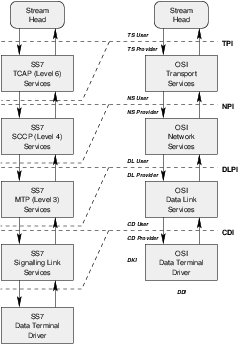
Each OpenSS7 protocol module provides standardized X/Open ISO/OSI interfaces as well as more SS7 specialized interfaces. Many of the OpenSS7 protocols modules provide TPI Revision 2.0 interfaces with support for the OpenSS7 XTI/TLI Library.

Figure 22 illustrates the organization of STREAMS modules, multiplexing drivers, pseudo-device drivers and real device drivers in the OpenSS7 SS7 stack. At each interface, the equivalent SIGTRAN User Adaptation Layer (UA) can be used. So, for example, between MTP Level 3 and its Users, the M3UA protocol can be employed. Each UA provides the same lower layer interface and upper layer interface. So, M3UA provides an MTP/MTP-User interface at its lower layer interface as well as at its upper layer interface.
7 Hardware Architecture
Figure 23 illustrates the hardware configuration for the OpenSS7 VoIP Switch evaluation platform.

The VoIP Switch prototype platform consists of a high-end ix86 single or multi processor PC loaded with Linux running a 2.4 production kernel, openss7-1.1.7.20141001 and the OpenSS7 stack software.
As a highly scalable and carrier grade alternative, the prototype system could use the CPC 388 cards running embedded Linux 2.4.18 (NexusWare24) on MPC8260 and performing backplane switching on H.100 and Ethernet rails on PCIMG 2.16 packet bus loaded with NexusWare (Linux 2.4.18), openss7-1.1.7.20141001 and the OpenSS7 stack software.
SS7 ISUP IMTs and signalling links are terminated on the telephone network side of the device on one of a number of TE410, CPC-384 or CPC-388 cards installed in either platform. On the other side of the platform, RTP connections are terminated on dual Ethernet devices or the PCIMG 2.16 packet bus. Signalling is performed over the same IP connections using BICC/M3UA (NNI), SIP (UNI) or H.245 (UNI). The OpenSS7 complex side of the device is attached directly to the IP backbone and signals to remote BICC switches, SIP proxies/clients or H.323 gatekeepers/clients.
The VoIP Switch prototype device performs conversion between the 64kbps voice channels terminated on the TE410, CPC-384 or CPC-388 cards on the telephone network side of the device to RTP streams on dual 10/100/1000 baseT or PICMG 2.16 packet bus using host or MPC8260 resources.
OAM&P of the prototype platform is performed over an internal LAN connection.
Hardware requirements are as follows:
- 1 x medium end (2.0 GHz) single processor, 19" rack mount, hardened chassis PC, 110 VAC commercial power.
- 2 x E400 Cards (or equivalent).
- 4 x 100baseT Ethernet NICs (3com 905B or equivalent).
For a redundant configuration (two hosts serving the same gateway), twice the hardware is required.
7.1 Interface Devices
The interface device hardware cards listed below are supported for the OpenSS7 Platform. All of the interface device hardware listed here has good price-performance, however, varying levels of performance (and therefore price) is available. These cards are available either directly from the card manufacturer or are also resold by OpenSS7 Corporation.
For the VoIP Switch application, either the CPC 388 cards are recommended.
The following interface device hardware is available for the OpenSS7 Platform:
7.1.1 T400P/E400P
The T400P and E400P cards are 4-span T1 or E1 cards manufactured by Varion. These cards were previously manufactured by Digium. Figure 24 shows a picture of a T400P card.
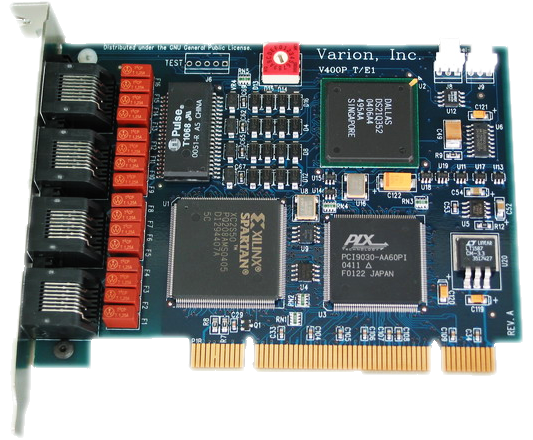
The T400P and E400P cards have the lowest level of signalling performance due to the lack of on-board HDLC functions. Transfers to the host processor over the PCI bus use PCI I/O ports and memory mapping.
Driver
These cards are supported by the X400 driver.
The function of the T/E400P Channel driver is to provide for the termination of 2.048Mbps, 1.544Mbps, 64kbps and 56kbps digital paths. This driver provides direct access to the channelized or unchannelized T1 or E1 digital paths to OpenSS7 media and signalling protocol modules as well as providing T1 or E1 management, framing, coding, alarms, and synchronization.
Features
Following are the features of the T400P and E400P cards:
- 4 T1 or E1 spans per card.
- Dallas framer.
- PLX PCI 9030 PCI bus chip.
- Xilinx Spartan XC2S50 processor.
- Raw transfer of octets from framers to PCI bus.
- Uses OpenSS7 Soft-HDLC engine for SS7, ISDN and ISO.
- 96 channels per card (T400P)
- 124 channels per card (E400P).
- Full span addressable.
Advantages
Following are the advantages of the T400P and E400P cards:
- Low cost.
- PC Compatibility.
- Released by Jim Dixon under the GNU Public License.
- Open Hardware design: schematics, artwork and Gerber plots available.
- Flash programmable Xilinx chip.
- Field upgradable.
- Supports a number of Open Source drivers.
- Asterisk driver support.
Disadvantages
Following are the disadvantages of the T400P and E400P cards:
- Lower performance.
- No on-board HLDC.
- Cannot TDM switch on card or between cards, media channels must be transferred through host to switch between cards.
- I/O Port and Memory Map instead of PCI DMA bus-mastering and burst transfers.
- Does not run on high speed buses.
- No integrated Ethernet for SIGTRAN and VoIP applications.
- Synchronization per-card instead of per-system.
Ultimately, the performance limiting factor of the T400P and E400P cards is the bandwidth of the PCI bus and the ability of the processor to perform Soft-HDLC and TDM switching in software. A 350MHz processor is capable of processing the bandwidth of an entire E400P card (124 signalling links) with a combined link throughput of 8.192 Mbps.
For the OpenSS7 VoIP Switch, this performance is more than adequate. A medium grade 2GHz PC should be capable of handling 2 cards (248 SS7 links) with adequate excess capacity available for background operations.
These cards are very cost-effective and can provide 64kbps SS7 links at average incremental interface cost of approximately $8.00 USD per signalling link.
7.1.2 TE405/410
The TE405/410 cards are 4-span E1/T1 cards manufactured by Digium. These cards are a higher performance replacement for the T400P and E400P cards. Figure 25 shows a picture of a T405P card.
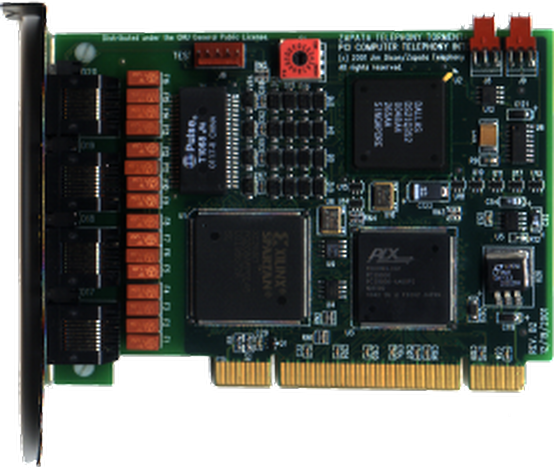
The TE405 and TE410 cards have a low level of signalling performance due to the lack of on-board HDLC functions. However, transfers to the host process over the PCI bus use bus-mastering PCI burst DMA transfers, unlike their T400P and E400P predecessors.
Driver
These cards are supported by the TE400 driver.
The function of the TE405/410 Channel driver is to provide for the termination of 2.048Mbps, 1.544Mbps, 64kbps and 56kbps digital paths. This driver provides direct access to the channelized or unchannelized T1 or E1 digital paths to OpenSS7 media and signalling protocol modules as well as providing T1 or E1 management, framing, coding, alarms, and synchronization.
Features
Following are the features of the TE405 and TE410 cards:
- 4 T1 or E1 spans per card.
- PMC Sierra framer
- PLX PCI 9030 PCI bus chip.
- Xilinx Spartan XC2S50 processor.
- Raw transfer of octets from framers to PCI bus.
- Uses OpenSS7 Soft-HDLC engine for SS7, ISDN and ISO.
- 96 channels per card (T1).
- 124 channels per card (E1).
- Full span addressable.
Advantages
Following are the advantages of the TE405 and TE410 cards:
- Lower cost.
- PCI DMA bus-mastering and burst transfers.
- Flash programmable Xilinx chip.
- Field upgradable.
- Supports a number of Open Source drivers.
- Asterisk driver support.
Disadvantages
Following are the disadvantages of the TE405 and TE410 cards:
- Lower performance, although better than predecessor.
- No on-board HLDC.
- Cannot TDM switch on card or between cards, media channels must be transferred through host to switch between cards.
- No integrated Ethernet for SIGTRAN and VoIP applications.
- Synchronization per-card instead of per-system.
As with their predecessors, the performance limiting factor of the TE405 and TE410 cards is the bandwidth of the PCI bus and the ability of the processor to perform Soft-HDLC and TDM switching in software. A 350MHz processor is capable of processing the bandwidth of an entire TE405 card (124 signalling link) with a combined linke throughput of 8.192 Mbps.
For the OpenSS7 VoIP Switch, this performance is more than adequate. A medium grade 2GHz PC should be capable of handling 2 cards (248 SS7 links) with adequate excess capacity available for background operations.
These cards are cost-effective and can provide 64kbps SS7 links at average incremental interface cost of approximately $12.00 USD per signalling link.
7.1.3 A101/102/104c
The A101/102/104c cards are 1-, 2- and 4-span E1, T1 or J1 cards manufactured by Sangoma. Figure 26 shows a picture of an A101c card.

The A10Xc cards have an increased level of signalling performance due to availability of on-board HDLC processing. Transfers to the host are performed using bus-mastering PCI DMA burst transfers for lower host processor overhead. These cards do not support direct on-board TDM switching; neither do they have integrated Ethernet.
Driver
These cards are supported by the A100 driver.
The function of the A100 Channel driver is to provide for the termination of 2.048Mbps, 1.544Mbps, 64kbps and 56kbps digital paths. This driver provides direct access to the channelized or unchannelized T1 or E1 digital paths to OpenSS7 media and signalling protocol modules as well as providing T1 or E1 management, framing, coding, alarms, and synchronization.
Features
Following are the features of the A101c, A102c and A104c cards:
- 1, 2 or 4 E1 spans per card.
- PMC Comet framer.
- Xilinx Spartan XC2S50 processor.
- Raw transfer of octets from framers to PCI bus.
- Can use OpenSS7 Soft-HDLC engines for SS7, ISDN and ISO.
- Also provides for onboard HLDC (SS7 DAEDR/DAEDT AERM/SUERM).
- 24, 48 and 96 channels per card (T1 A101, A102 and A104).
- 31, 62 and 124 channels per card (E1 A101, A102 and A104).
- Full span addressable.
Advantages
Following are the advantages of the A101, A102 and A104 cards:
- Low cost.
- PC Comaptibility.
- Homolgomation and world-wide support.
- Flash programmable Xilinx chip.
- Field upgradable.
- Supports a wide range of Open Source drivers.
- Linux kernel WAN support.
- Asterisk driver support.
Disadvantages
Following are the disadvantages of the A101, A102 and A104 cards:
- Cannot TDM switch on card or between cards, media channels must be transferred through host to switch between cards.
- No integrated Ethernet for SIGTRAN and VoIP applications.
- Synchronization per-card instead of per-system.
The performance limiting factor of the A101c, A102c and A104c cards is the bandwidth of the PCI bus and the ability of the processor to perform TDM switching is software.
For the OpenSS7 VoIP Switch, this performance is more than adequate, particularly as TDM switching is not a requirement for this pure signalling application. Although these cards lack integrated Ethernet support, for the non-redundant switching application, and where interworking between SIGTRAN and SS7 is not required, this is not a limitation.
These cards have excellent price-performance and can provide 64kbps SS7 links at average incremental interface cost of approximately $12.00 USD per signalling link.
7.1.4 Other Interface Cards
Additional interface cards could be implemented in other phases of the project. For additional information, see Optional Hardware Support.
8 Platform Architecture
This section details the platform architecture. The solution platform architecture consists of the computing platform and associated hardware, interfaces and peripherals.
Figure 13 illustrates the solution platform rack configuration.

The solution platform consists of the following:
- — One hardened PC (2U) chassis per system.
- — One 10/100/1000 Mblks (10/100/1000baseT) RJ-45c Layer 2 Ethernet Switch.
Platform Capacity
The PC chassis is equipped with the following: 20
8.1 HP cc3310 Based Platform
8.2 Dell PowerEdge 2650 Based Platform
9 System Architecture
This section details the solution system architecture. The solution system architecture consists of the computing platforms and their placement within the local installation environment.
The solution system has the following requirements:
- — 19" rack
- — 110 to 220 VAC or -48 VDC electical power.
- — Commercial cooling.
- — Bantam to RJ48c patch panel.
9.1 HP cc3310 Based System
9.2 Dell PowerEdge 2650 Based System
10 Logistics
10.1 Hardware
10.1.1 Sizing Considerations
10.2 Software
10.3 Consulting
10.4 Schedule
10.4.1 Gate 0 — Concept
10.4.2 Gate 1 — High-Level Design
10.4.3 Gate 2 — Detailed Design
10.4.4 Gate 3 — Development and Implementation
10.4.5 Gate 4 — System Test
10.4.6 Gate 5 — Acceptance Testing
10.4.7 Gate 6 — Support Complete
10.5 Cost
Appendix A Optional Application Support
A.1 Other Solution Architecture
A.1.1 ISDN to ISUP Conversion
Appendix B Optional Network Support
B.1 VoIP Switch Reference Interfaces
Appendix C Optional Protocol Support
C.1 Other Protocol Components
C.1.1 SCCP User Adaptation Layer (SUA) Driver
The SUA driver provides the OpenSS7 VoIP Switch with the ability to act as an SUA AS (Application Server) in conjunction with an SUA SG (Signalling Gateway). In this project, the SG function is performed by existing lab equipment. The SUA driver accepts the transport of the SCCP to SCCP-User interface from the SG to the MGC. The SUA driver links SCTP driver streams underneath it to provide the transport services for exporting the SCCP-User interface. The SUA driver provides the same interfaces to its users as the OpenSS7 SCCP.
The SUA driver is a STREAMS driver that runs in the Linux kernel for maximum performance.
C.1.2 MTP Level 3 Broadband (MTP3b) Module
C.1.3 Service Specific Connection Oriented Protocol (SSCOP) Driver
C.1.4 MTP Level 2 User Adaptation Layer (M2UA) Driver
The M2UA driver provides the OpenSS7 VoIP Switch with the ability to act as an M2UA AS (Application Server) in conjunction with an M2UA SG (Signalling Gateway). In this project, the SG function is performed by existing lab equipment. The M2UA driver accepts the transport of the SL to SL-User interface from the SG to the MGC. The M2UA driver links SCTP driver streams underneath it to provide the transport services for exporting the SL-User interface. The M2UA driver provides the same interface to its users as the OpenSS7 SL module.
Appendix D Optional Software Support
D.1 Operating System Options
D.2 STREAMS Options
D.2.1 Linux Fast-STREAMS (LfS)
Appendix E Optional Hardware Support
E.1 Other Interface Devices
This section provides information on additional interface cards available for use with the OpenSS7 SS7, SIGTRAN, ISDN and VoIP stacks:
E.1.1 ACB56
The ACB56 cards are single V.35 56/64kbps synchronous cards manufactured by SeaLevel Systems and distributed by ICS. Figure A-13 shows a picture of an ACB56 card.
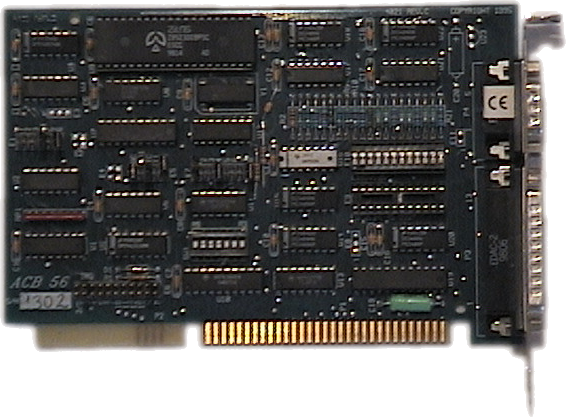
Driver
The driver for the ACB56 card provides, CH, SDL or SDT access to the card. The CH or SDL driver places the Zilog part into transparent mode and passes octets directly off the line to the channel or signalling data link driver. The SDT driver places the Zilog part into HDLC mode and performs SS7 HDLC using the Zilog SCC. The SDT driver performs better, of course, than the CH or SDL drivers, however, the Zilog SCC HDLC is incapable of performing some SS7 functions that are provided by the OpenSS7 SDT (SS7-HDLC) module for the CH or SDL drivers.
Features
Following are some features of the ACB56 card:
- 1 x V.35 56kbps or 64 kbps synchronous port on DB-25 connector.
- DB-25 to N-type cable available.
- 56 kbps or 64kbps DTE mode.
- 56 kbps DCE mode.
- Based on Zilog 80585 Serial Communications Controller (SCC).
- ISA Bus.
- Supports dual-channel ISA DMA.
- Also supports RS-232C although not useful for SS7.
Advantages
Following are the advantages of the ACB56 card:
- Provides V.35 interface where necessary.
The ACB56 card has few advantages. It only provides low-cost V.35 interface where absolutely necessary. Any other V.35 capable card might be a better choice.
Disadvantages
Following are the disadvantages of the ACB56 card:
- ISA bus.
- Low density.
- Limited number of cards per host due to ISA IRQ and DMA limitations.
- Needs external CSU/DSU.
- Does not support TDM voice channels.
Due to its disadvantages, another V.35 card (PCI based, higher density, integrated CSU/DSU) should be considered where V.35 interface is completely necessary.
The OpenSS7 VoIP Switch does not have a requirement for V.35 interface and this card is not used on the deployment platform. If V.35 interface becomes a requirement at a later date, a different card will be selected. The selected card will have a higher density, PCI with PCI DMA and bus-mastering, integrated CSU/DSU, and other features absent from the ACB56 card.
E.1.2 PCA 200E
The PCA 200E card is a 155MHz ATM card manufactured by Marconi (formerly FORE). Figure A-16 shows a picture of an PCA 200E card.
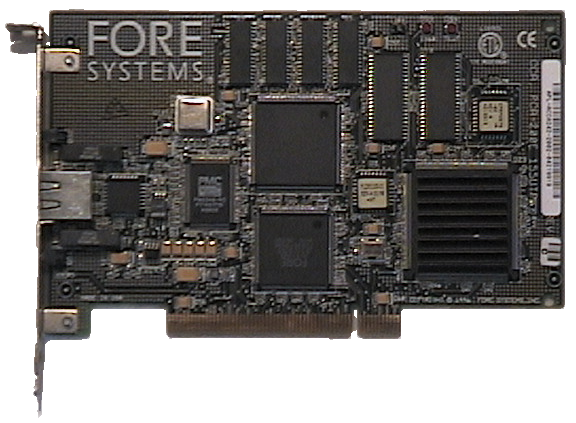
The PCA 200E cards have a good level of signalling performance because they have an on-board 25MHz i960 Intel RISC processor performing cell processing using buffer rings in the same manner as an Ethernet controller.
Driver
Features
Following are the features of the PCA 200E cards:
- 155 MHz ATM, ST/SC SM/MM and RJ-45 UTP 5
- AAL1, AAL2, AAL3 and AAL5 modes.
- Integrated 25 MHz i960 RISC cell processor.
- Enhance SAR Processor (ESP) ASIC
- Special-purpose hardware for AAL5 and AAL3/4, HEC, and CRC calculations.
- Dual-ported RAM and Buffer Ring technique similar to Ethernet Controller.
- Serial communications emulation.
- Supports ABR
- ATM cell processing per ANSI T1S1.5/92-002R3, ITU I.361, ATM Form UNI v3.0, 3.1, 4.0
Advantages
Following are the advantages of the PCA 200E cards:
- Inexpensive (about $200 a card).
- Supports MTP3b.
- Can support 3GPP UMTS Iu User and Control Plane over PVCs.
Disadvantages
Following are the disadvantages of the PCA 200E cards:
- Does not support traditional SS7 links.
- Requires external ATM switch or point-to-point ATM connection.
E.1.3 BRI
A BRI card.

Driver
Features
Following are the features of the BRI cards:
Advantages
Following are the advantages of the BRI cards:
Disadvantages
Following are the disadvantages of the BRI cards:
Appendix F Programmatic Interfaces
Appendix G Platform Sizing
Licenses
All code presented in this manual is licensed under the GNU Affero General Public License. The text of this manual is licensed under the GNU Free Documentation License, with no Invariant Sections, no Front-Cover Texts and no Back-Cover Texts. Please note, however, that it is just plain wrong to modify statements of, or attribute statements to, the Author or OpenSS7 Corporation.
GNU Affero General Public License
Copyright © 2007 Free Software Foundation, Inc. http://fsf.org/ Everyone is permitted to copy and distribute verbatim copies of this license document, but changing it is not allowed.
Preamble
The GNU Affero General Public License is a free, copyleft license for software and other kinds of works, specifically designed to ensure cooperation with the community in the case of network server software.
The licenses for most software and other practical works are designed to take away your freedom to share and change the works. By contrast, our General Public Licenses are intended to guarantee your freedom to share and change all versions of a program–to make sure it remains free software for all its users.
When we speak of free software, we are referring to freedom, not price. Our General Public Licenses are designed to make sure that you have the freedom to distribute copies of free software (and charge for them if you wish), that you receive source code or can get it if you want it, that you can change the software or use pieces of it in new free programs, and that you know you can do these things.
Developers that use our General Public Licenses protect your rights with two steps: (1) assert copyright on the software, and (2) offer you this License which gives you legal permission to copy, distribute and/or modify the software.
A secondary benefit of defending all users’ freedom is that improvements made in alternate versions of the program, if they receive widespread use, become available for other developers to incorporate. Many developers of free software are heartened and encouraged by the resulting cooperation. However, in the case of software used on network servers, this result may fail to come about. The GNU General Public License permits making a modified version and letting the public access it on a server without ever releasing its source code to the public.
The GNU Affero General Public License is designed specifically to ensure that, in such cases, the modified source code becomes available to the community. It requires the operator of a network server to provide the source code of the modified version running there to the users of that server. Therefore, public use of a modified version, on a publicly accessible server, gives the public access to the source code of the modified version.
An older license, called the Affero General Public License and published by Affero, was designed to accomplish similar goals. This is a different license, not a version of the Affero GPL, but Affero has released a new version of the Affero GPL which permits relicensing under this license.
The precise terms and conditions for copying, distribution and modification follow.
- Definitions.
“This License” refers to version 3 of the GNU Affero General Public License.
“Copyright” also means copyright-like laws that apply to other kinds of works, such as semiconductor masks.
“The Program” refers to any copyrightable work licensed under this License. Each licensee is addressed as “you”. “Licensees” and “recipients” may be individuals or organizations.
To “modify” a work means to copy from or adapt all or part of the work in a fashion requiring copyright permission, other than the making of an exact copy. The resulting work is called a “modified version” of the earlier work or a work “based on” the earlier work.
A “covered work” means either the unmodified Program or a work based on the Program.
To “propagate” a work means to do anything with it that, without permission, would make you directly or secondarily liable for infringement under applicable copyright law, except executing it on a computer or modifying a private copy. Propagation includes copying, distribution (with or without modification), making available to the public, and in some countries other activities as well.
To “convey” a work means any kind of propagation that enables other parties to make or receive copies. Mere interaction with a user through a computer network, with no transfer of a copy, is not conveying.
An interactive user interface displays “Appropriate Legal Notices” to the extent that it includes a convenient and prominently visible feature that (1) displays an appropriate copyright notice, and (2) tells the user that there is no warranty for the work (except to the extent that warranties are provided), that licensees may convey the work under this License, and how to view a copy of this License. If the interface presents a list of user commands or options, such as a menu, a prominent item in the list meets this criterion.
- Source Code.
The “source code” for a work means the preferred form of the work for making modifications to it. “Object code” means any non-source form of a work.
A “Standard Interface” means an interface that either is an official standard defined by a recognized standards body, or, in the case of interfaces specified for a particular programming language, one that is widely used among developers working in that language.
The “System Libraries” of an executable work include anything, other than the work as a whole, that (a) is included in the normal form of packaging a Major Component, but which is not part of that Major Component, and (b) serves only to enable use of the work with that Major Component, or to implement a Standard Interface for which an implementation is available to the public in source code form. A “Major Component”, in this context, means a major essential component (kernel, window system, and so on) of the specific operating system (if any) on which the executable work runs, or a compiler used to produce the work, or an object code interpreter used to run it.
The “Corresponding Source” for a work in object code form means all the source code needed to generate, install, and (for an executable work) run the object code and to modify the work, including scripts to control those activities. However, it does not include the work’s System Libraries, or general-purpose tools or generally available free programs which are used unmodified in performing those activities but which are not part of the work. For example, Corresponding Source includes interface definition files associated with source files for the work, and the source code for shared libraries and dynamically linked subprograms that the work is specifically designed to require, such as by intimate data communication or control flow between those subprograms and other parts of the work.
The Corresponding Source need not include anything that users can regenerate automatically from other parts of the Corresponding Source.
The Corresponding Source for a work in source code form is that same work.
- Basic Permissions.
All rights granted under this License are granted for the term of copyright on the Program, and are irrevocable provided the stated conditions are met. This License explicitly affirms your unlimited permission to run the unmodified Program. The output from running a covered work is covered by this License only if the output, given its content, constitutes a covered work. This License acknowledges your rights of fair use or other equivalent, as provided by copyright law.
You may make, run and propagate covered works that you do not convey, without conditions so long as your license otherwise remains in force. You may convey covered works to others for the sole purpose of having them make modifications exclusively for you, or provide you with facilities for running those works, provided that you comply with the terms of this License in conveying all material for which you do not control copyright. Those thus making or running the covered works for you must do so exclusively on your behalf, under your direction and control, on terms that prohibit them from making any copies of your copyrighted material outside their relationship with you.
Conveying under any other circumstances is permitted solely under the conditions stated below. Sublicensing is not allowed; section 10 makes it unnecessary.
- Protecting Users’ Legal Rights From Anti-Circumvention Law.
No covered work shall be deemed part of an effective technological measure under any applicable law fulfilling obligations under article 11 of the WIPO copyright treaty adopted on 20 December 1996, or similar laws prohibiting or restricting circumvention of such measures.
When you convey a covered work, you waive any legal power to forbid circumvention of technological measures to the extent such circumvention is effected by exercising rights under this License with respect to the covered work, and you disclaim any intention to limit operation or modification of the work as a means of enforcing, against the work’s users, your or third parties’ legal rights to forbid circumvention of technological measures.
- Conveying Verbatim Copies.
You may convey verbatim copies of the Program’s source code as you receive it, in any medium, provided that you conspicuously and appropriately publish on each copy an appropriate copyright notice; keep intact all notices stating that this License and any non-permissive terms added in accord with section 7 apply to the code; keep intact all notices of the absence of any warranty; and give all recipients a copy of this License along with the Program.
You may charge any price or no price for each copy that you convey, and you may offer support or warranty protection for a fee.
- Conveying Modified Source Versions.
You may convey a work based on the Program, or the modifications to produce it from the Program, in the form of source code under the terms of section 4, provided that you also meet all of these conditions:
- The work must carry prominent notices stating that you modified it, and giving a relevant date.
- The work must carry prominent notices stating that it is released under this License and any conditions added under section 7. This requirement modifies the requirement in section 4 to “keep intact all notices”.
- You must license the entire work, as a whole, under this License to anyone who comes into possession of a copy. This License will therefore apply, along with any applicable section 7 additional terms, to the whole of the work, and all its parts, regardless of how they are packaged. This License gives no permission to license the work in any other way, but it does not invalidate such permission if you have separately received it.
- If the work has interactive user interfaces, each must display Appropriate Legal Notices; however, if the Program has interactive interfaces that do not display Appropriate Legal Notices, your work need not make them do so.
A compilation of a covered work with other separate and independent works, which are not by their nature extensions of the covered work, and which are not combined with it such as to form a larger program, in or on a volume of a storage or distribution medium, is called an “aggregate” if the compilation and its resulting copyright are not used to limit the access or legal rights of the compilation’s users beyond what the individual works permit. Inclusion of a covered work in an aggregate does not cause this License to apply to the other parts of the aggregate.
- Conveying Non-Source Forms.
You may convey a covered work in object code form under the terms of sections 4 and 5, provided that you also convey the machine-readable Corresponding Source under the terms of this License, in one of these ways:
- Convey the object code in, or embodied in, a physical product (including a physical distribution medium), accompanied by the Corresponding Source fixed on a durable physical medium customarily used for software interchange.
- Convey the object code in, or embodied in, a physical product (including a physical distribution medium), accompanied by a written offer, valid for at least three years and valid for as long as you offer spare parts or customer support for that product model, to give anyone who possesses the object code either (1) a copy of the Corresponding Source for all the software in the product that is covered by this License, on a durable physical medium customarily used for software interchange, for a price no more than your reasonable cost of physically performing this conveying of source, or (2) access to copy the Corresponding Source from a network server at no charge.
- Convey individual copies of the object code with a copy of the written offer to provide the Corresponding Source. This alternative is allowed only occasionally and noncommercially, and only if you received the object code with such an offer, in accord with subsection 6b.
- Convey the object code by offering access from a designated place (gratis or for a charge), and offer equivalent access to the Corresponding Source in the same way through the same place at no further charge. You need not require recipients to copy the Corresponding Source along with the object code. If the place to copy the object code is a network server, the Corresponding Source may be on a different server (operated by you or a third party) that supports equivalent copying facilities, provided you maintain clear directions next to the object code saying where to find the Corresponding Source. Regardless of what server hosts the Corresponding Source, you remain obligated to ensure that it is available for as long as needed to satisfy these requirements.
- Convey the object code using peer-to-peer transmission, provided you inform other peers where the object code and Corresponding Source of the work are being offered to the general public at no charge under subsection 6d.
A separable portion of the object code, whose source code is excluded from the Corresponding Source as a System Library, need not be included in conveying the object code work.
A “User Product” is either (1) a “consumer product”, which means any tangible personal property which is normally used for personal, family, or household purposes, or (2) anything designed or sold for incorporation into a dwelling. In determining whether a product is a consumer product, doubtful cases shall be resolved in favor of coverage. For a particular product received by a particular user, “normally used” refers to a typical or common use of that class of product, regardless of the status of the particular user or of the way in which the particular user actually uses, or expects or is expected to use, the product. A product is a consumer product regardless of whether the product has substantial commercial, industrial or non-consumer uses, unless such uses represent the only significant mode of use of the product.
“Installation Information” for a User Product means any methods, procedures, authorization keys, or other information required to install and execute modified versions of a covered work in that User Product from a modified version of its Corresponding Source. The information must suffice to ensure that the continued functioning of the modified object code is in no case prevented or interfered with solely because modification has been made.
If you convey an object code work under this section in, or with, or specifically for use in, a User Product, and the conveying occurs as part of a transaction in which the right of possession and use of the User Product is transferred to the recipient in perpetuity or for a fixed term (regardless of how the transaction is characterized), the Corresponding Source conveyed under this section must be accompanied by the Installation Information. But this requirement does not apply if neither you nor any third party retains the ability to install modified object code on the User Product (for example, the work has been installed in ROM).
The requirement to provide Installation Information does not include a requirement to continue to provide support service, warranty, or updates for a work that has been modified or installed by the recipient, or for the User Product in which it has been modified or installed. Access to a network may be denied when the modification itself materially and adversely affects the operation of the network or violates the rules and protocols for communication across the network.
Corresponding Source conveyed, and Installation Information provided, in accord with this section must be in a format that is publicly documented (and with an implementation available to the public in source code form), and must require no special password or key for unpacking, reading or copying.
- Additional Terms.
“Additional permissions” are terms that supplement the terms of this License by making exceptions from one or more of its conditions. Additional permissions that are applicable to the entire Program shall be treated as though they were included in this License, to the extent that they are valid under applicable law. If additional permissions apply only to part of the Program, that part may be used separately under those permissions, but the entire Program remains governed by this License without regard to the additional permissions.
When you convey a copy of a covered work, you may at your option remove any additional permissions from that copy, or from any part of it. (Additional permissions may be written to require their own removal in certain cases when you modify the work.) You may place additional permissions on material, added by you to a covered work, for which you have or can give appropriate copyright permission.
Notwithstanding any other provision of this License, for material you add to a covered work, you may (if authorized by the copyright holders of that material) supplement the terms of this License with terms:
- Disclaiming warranty or limiting liability differently from the terms of sections 15 and 16 of this License; or
- Requiring preservation of specified reasonable legal notices or author attributions in that material or in the Appropriate Legal Notices displayed by works containing it; or
- Prohibiting misrepresentation of the origin of that material, or requiring that modified versions of such material be marked in reasonable ways as different from the original version; or
- Limiting the use for publicity purposes of names of licensors or authors of the material; or
- Declining to grant rights under trademark law for use of some trade names, trademarks, or service marks; or
- Requiring indemnification of licensors and authors of that material by anyone who conveys the material (or modified versions of it) with contractual assumptions of liability to the recipient, for any liability that these contractual assumptions directly impose on those licensors and authors.
All other non-permissive additional terms are considered “further restrictions” within the meaning of section 10. If the Program as you received it, or any part of it, contains a notice stating that it is governed by this License along with a term that is a further restriction, you may remove that term. If a license document contains a further restriction but permits relicensing or conveying under this License, you may add to a covered work material governed by the terms of that license document, provided that the further restriction does not survive such relicensing or conveying.
If you add terms to a covered work in accord with this section, you must place, in the relevant source files, a statement of the additional terms that apply to those files, or a notice indicating where to find the applicable terms.
Additional terms, permissive or non-permissive, may be stated in the form of a separately written license, or stated as exceptions; the above requirements apply either way.
- Termination.
You may not propagate or modify a covered work except as expressly provided under this License. Any attempt otherwise to propagate or modify it is void, and will automatically terminate your rights under this License (including any patent licenses granted under the third paragraph of section 11).
However, if you cease all violation of this License, then your license from a particular copyright holder is reinstated (a) provisionally, unless and until the copyright holder explicitly and finally terminates your license, and (b) permanently, if the copyright holder fails to notify you of the violation by some reasonable means prior to 60 days after the cessation.
Moreover, your license from a particular copyright holder is reinstated permanently if the copyright holder notifies you of the violation by some reasonable means, this is the first time you have received notice of violation of this License (for any work) from that copyright holder, and you cure the violation prior to 30 days after your receipt of the notice.
Termination of your rights under this section does not terminate the licenses of parties who have received copies or rights from you under this License. If your rights have been terminated and not permanently reinstated, you do not qualify to receive new licenses for the same material under section 10.
- Acceptance Not Required for Having Copies.
You are not required to accept this License in order to receive or run a copy of the Program. Ancillary propagation of a covered work occurring solely as a consequence of using peer-to-peer transmission to receive a copy likewise does not require acceptance. However, nothing other than this License grants you permission to propagate or modify any covered work. These actions infringe copyright if you do not accept this License. Therefore, by modifying or propagating a covered work, you indicate your acceptance of this License to do so.
- Automatic Licensing of Downstream Recipients.
Each time you convey a covered work, the recipient automatically receives a license from the original licensors, to run, modify and propagate that work, subject to this License. You are not responsible for enforcing compliance by third parties with this License.
An “entity transaction” is a transaction transferring control of an organization, or substantially all assets of one, or subdividing an organization, or merging organizations. If propagation of a covered work results from an entity transaction, each party to that transaction who receives a copy of the work also receives whatever licenses to the work the party’s predecessor in interest had or could give under the previous paragraph, plus a right to possession of the Corresponding Source of the work from the predecessor in interest, if the predecessor has it or can get it with reasonable efforts.
You may not impose any further restrictions on the exercise of the rights granted or affirmed under this License. For example, you may not impose a license fee, royalty, or other charge for exercise of rights granted under this License, and you may not initiate litigation (including a cross-claim or counterclaim in a lawsuit) alleging that any patent claim is infringed by making, using, selling, offering for sale, or importing the Program or any portion of it.
- Patents.
A “contributor” is a copyright holder who authorizes use under this License of the Program or a work on which the Program is based. The work thus licensed is called the contributor’s “contributor version”.
A contributor’s “essential patent claims” are all patent claims owned or controlled by the contributor, whether already acquired or hereafter acquired, that would be infringed by some manner, permitted by this License, of making, using, or selling its contributor version, but do not include claims that would be infringed only as a consequence of further modification of the contributor version. For purposes of this definition, “control” includes the right to grant patent sublicenses in a manner consistent with the requirements of this License.
Each contributor grants you a non-exclusive, worldwide, royalty-free patent license under the contributor’s essential patent claims, to make, use, sell, offer for sale, import and otherwise run, modify and propagate the contents of its contributor version.
In the following three paragraphs, a “patent license” is any express agreement or commitment, however denominated, not to enforce a patent (such as an express permission to practice a patent or covenant not to sue for patent infringement). To “grant” such a patent license to a party means to make such an agreement or commitment not to enforce a patent against the party.
If you convey a covered work, knowingly relying on a patent license, and the Corresponding Source of the work is not available for anyone to copy, free of charge and under the terms of this License, through a publicly available network server or other readily accessible means, then you must either (1) cause the Corresponding Source to be so available, or (2) arrange to deprive yourself of the benefit of the patent license for this particular work, or (3) arrange, in a manner consistent with the requirements of this License, to extend the patent license to downstream recipients. “Knowingly relying” means you have actual knowledge that, but for the patent license, your conveying the covered work in a country, or your recipient’s use of the covered work in a country, would infringe one or more identifiable patents in that country that you have reason to believe are valid.
If, pursuant to or in connection with a single transaction or arrangement, you convey, or propagate by procuring conveyance of, a covered work, and grant a patent license to some of the parties receiving the covered work authorizing them to use, propagate, modify or convey a specific copy of the covered work, then the patent license you grant is automatically extended to all recipients of the covered work and works based on it.
A patent license is “discriminatory” if it does not include within the scope of its coverage, prohibits the exercise of, or is conditioned on the non-exercise of one or more of the rights that are specifically granted under this License. You may not convey a covered work if you are a party to an arrangement with a third party that is in the business of distributing software, under which you make payment to the third party based on the extent of your activity of conveying the work, and under which the third party grants, to any of the parties who would receive the covered work from you, a discriminatory patent license (a) in connection with copies of the covered work conveyed by you (or copies made from those copies), or (b) primarily for and in connection with specific products or compilations that contain the covered work, unless you entered into that arrangement, or that patent license was granted, prior to 28 March 2007.
Nothing in this License shall be construed as excluding or limiting any implied license or other defenses to infringement that may otherwise be available to you under applicable patent law.
- No Surrender of Others’ Freedom.
If conditions are imposed on you (whether by court order, agreement or otherwise) that contradict the conditions of this License, they do not excuse you from the conditions of this License. If you cannot convey a covered work so as to satisfy simultaneously your obligations under this License and any other pertinent obligations, then as a consequence you may not convey it at all. For example, if you agree to terms that obligate you to collect a royalty for further conveying from those to whom you convey the Program, the only way you could satisfy both those terms and this License would be to refrain entirely from conveying the Program.
- Remote Network Interaction; Use with the GNU General Public License.
Notwithstanding any other provision of this License, if you modify the Program, your modified version must prominently offer all users interacting with it remotely through a network (if your version supports such interaction) an opportunity to receive the Corresponding Source of your version by providing access to the Corresponding Source from a network server at no charge, through some standard or customary means of facilitating copying of software. This Corresponding Source shall include the Corresponding Source for any work covered by version 3 of the GNU General Public License that is incorporated pursuant to the following paragraph.
Notwithstanding any other provision of this License, you have permission to link or combine any covered work with a work licensed under version 3 of the GNU General Public License into a single combined work, and to convey the resulting work. The terms of this License will continue to apply to the part which is the covered work, but the work with which it is combined will remain governed by version 3 of the GNU General Public License.
- Revised Versions of this License.
The Free Software Foundation may publish revised and/or new versions of the GNU Affero General Public License from time to time. Such new versions will be similar in spirit to the present version, but may differ in detail to address new problems or concerns.
Each version is given a distinguishing version number. If the Program specifies that a certain numbered version of the GNU Affero General Public License “or any later version” applies to it, you have the option of following the terms and conditions either of that numbered version or of any later version published by the Free Software Foundation. If the Program does not specify a version number of the GNU Affero General Public License, you may choose any version ever published by the Free Software Foundation.
If the Program specifies that a proxy can decide which future versions of the GNU Affero General Public License can be used, that proxy’s public statement of acceptance of a version permanently authorizes you to choose that version for the Program.
Later license versions may give you additional or different permissions. However, no additional obligations are imposed on any author or copyright holder as a result of your choosing to follow a later version.
- Disclaimer of Warranty.
THERE IS NO WARRANTY FOR THE PROGRAM, TO THE EXTENT PERMITTED BY APPLICABLE LAW. EXCEPT WHEN OTHERWISE STATED IN WRITING THE COPYRIGHT HOLDERS AND/OR OTHER PARTIES PROVIDE THE PROGRAM “AS IS” WITHOUT WARRANTY OF ANY KIND, EITHER EXPRESSED OR IMPLIED, INCLUDING, BUT NOT LIMITED TO, THE IMPLIED WARRANTIES OF MERCHANTABILITY AND FITNESS FOR A PARTICULAR PURPOSE. THE ENTIRE RISK AS TO THE QUALITY AND PERFORMANCE OF THE PROGRAM IS WITH YOU. SHOULD THE PROGRAM PROVE DEFECTIVE, YOU ASSUME THE COST OF ALL NECESSARY SERVICING, REPAIR OR CORRECTION.
- Limitation of Liability.
IN NO EVENT UNLESS REQUIRED BY APPLICABLE LAW OR AGREED TO IN WRITING WILL ANY COPYRIGHT HOLDER, OR ANY OTHER PARTY WHO MODIFIES AND/OR CONVEYS THE PROGRAM AS PERMITTED ABOVE, BE LIABLE TO YOU FOR DAMAGES, INCLUDING ANY GENERAL, SPECIAL, INCIDENTAL OR CONSEQUENTIAL DAMAGES ARISING OUT OF THE USE OR INABILITY TO USE THE PROGRAM (INCLUDING BUT NOT LIMITED TO LOSS OF DATA OR DATA BEING RENDERED INACCURATE OR LOSSES SUSTAINED BY YOU OR THIRD PARTIES OR A FAILURE OF THE PROGRAM TO OPERATE WITH ANY OTHER PROGRAMS), EVEN IF SUCH HOLDER OR OTHER PARTY HAS BEEN ADVISED OF THE POSSIBILITY OF SUCH DAMAGES.
- Interpretation of Sections 15 and 16.
If the disclaimer of warranty and limitation of liability provided above cannot be given local legal effect according to their terms, reviewing courts shall apply local law that most closely approximates an absolute waiver of all civil liability in connection with the Program, unless a warranty or assumption of liability accompanies a copy of the Program in return for a fee.
How to Apply These Terms to Your New Programs
If you develop a new program, and you want it to be of the greatest possible use to the public, the best way to achieve this is to make it free software which everyone can redistribute and change under these terms.
To do so, attach the following notices to the program. It is safest to attach them to the start of each source file to most effectively state the exclusion of warranty; and each file should have at least the “copyright” line and a pointer to where the full notice is found.
one line to give the program's name and a brief idea of what it does. Copyright (C) year name of author This program is free software: you can redistribute it and/or modify it under the terms of the GNU Affero General Public License as published by the Free Software Foundation, either version 3 of the License, or (at your option) any later version. This program is distributed in the hope that it will be useful, but WITHOUT ANY WARRANTY; without even the implied warranty of MERCHANTABILITY or FITNESS FOR A PARTICULAR PURPOSE. See the GNU Affero General Public License for more details. You should have received a copy of the GNU Affero General Public License along with this program. If not, see http://www.gnu.org/licenses/.
Also add information on how to contact you by electronic and paper mail.
If your software can interact with users remotely through a network, you should also make sure that it provides a way for users to get its source. For example, if your program is a web application, its interface could display a “Source” link that leads users to an archive of the code. There are many ways you could offer source, and different solutions will be better for different programs; see section 13 for the specific requirements.
You should also get your employer (if you work as a programmer) or school, if any, to sign a “copyright disclaimer” for the program, if necessary. For more information on this, and how to apply and follow the GNU AGPL, see http://www.gnu.org/licenses/.
GNU Free Documentation License
Copyright © 2000, 2001, 2002, 2007, 2008 Free Software Foundation, Inc. http://fsf.org/ Everyone is permitted to copy and distribute verbatim copies of this license document, but changing it is not allowed.
- PREAMBLE
The purpose of this License is to make a manual, textbook, or other functional and useful document free in the sense of freedom: to assure everyone the effective freedom to copy and redistribute it, with or without modifying it, either commercially or noncommercially. Secondarily, this License preserves for the author and publisher a way to get credit for their work, while not being considered responsible for modifications made by others.
This License is a kind of “copyleft”, which means that derivative works of the document must themselves be free in the same sense. It complements the GNU General Public License, which is a copyleft license designed for free software.
We have designed this License in order to use it for manuals for free software, because free software needs free documentation: a free program should come with manuals providing the same freedoms that the software does. But this License is not limited to software manuals; it can be used for any textual work, regardless of subject matter or whether it is published as a printed book. We recommend this License principally for works whose purpose is instruction or reference.
- APPLICABILITY AND DEFINITIONS
This License applies to any manual or other work, in any medium, that contains a notice placed by the copyright holder saying it can be distributed under the terms of this License. Such a notice grants a world-wide, royalty-free license, unlimited in duration, to use that work under the conditions stated herein. The “Document”, below, refers to any such manual or work. Any member of the public is a licensee, and is addressed as “you”. You accept the license if you copy, modify or distribute the work in a way requiring permission under copyright law.
A “Modified Version” of the Document means any work containing the Document or a portion of it, either copied verbatim, or with modifications and/or translated into another language.
A “Secondary Section” is a named appendix or a front-matter section of the Document that deals exclusively with the relationship of the publishers or authors of the Document to the Document’s overall subject (or to related matters) and contains nothing that could fall directly within that overall subject. (Thus, if the Document is in part a textbook of mathematics, a Secondary Section may not explain any mathematics.) The relationship could be a matter of historical connection with the subject or with related matters, or of legal, commercial, philosophical, ethical or political position regarding them.
The “Invariant Sections” are certain Secondary Sections whose titles are designated, as being those of Invariant Sections, in the notice that says that the Document is released under this License. If a section does not fit the above definition of Secondary then it is not allowed to be designated as Invariant. The Document may contain zero Invariant Sections. If the Document does not identify any Invariant Sections then there are none.
The “Cover Texts” are certain short passages of text that are listed, as Front-Cover Texts or Back-Cover Texts, in the notice that says that the Document is released under this License. A Front-Cover Text may be at most 5 words, and a Back-Cover Text may be at most 25 words.
A “Transparent” copy of the Document means a machine-readable copy, represented in a format whose specification is available to the general public, that is suitable for revising the document straightforwardly with generic text editors or (for images composed of pixels) generic paint programs or (for drawings) some widely available drawing editor, and that is suitable for input to text formatters or for automatic translation to a variety of formats suitable for input to text formatters. A copy made in an otherwise Transparent file format whose markup, or absence of markup, has been arranged to thwart or discourage subsequent modification by readers is not Transparent. An image format is not Transparent if used for any substantial amount of text. A copy that is not “Transparent” is called “Opaque”.
Examples of suitable formats for Transparent copies include plain ASCII without markup, Texinfo input format, LaTeX input format, SGML or XML using a publicly available DTD, and standard-conforming simple HTML, PostScript or PDF designed for human modification. Examples of transparent image formats include PNG, XCF and JPG. Opaque formats include proprietary formats that can be read and edited only by proprietary word processors, SGML or XML for which the DTD and/or processing tools are not generally available, and the machine-generated HTML, PostScript or PDF produced by some word processors for output purposes only.
The “Title Page” means, for a printed book, the title page itself, plus such following pages as are needed to hold, legibly, the material this License requires to appear in the title page. For works in formats which do not have any title page as such, “Title Page” means the text near the most prominent appearance of the work’s title, preceding the beginning of the body of the text.
The “publisher” means any person or entity that distributes copies of the Document to the public.
A section “Entitled XYZ” means a named subunit of the Document whose title either is precisely XYZ or contains XYZ in parentheses following text that translates XYZ in another language. (Here XYZ stands for a specific section name mentioned below, such as “Acknowledgements”, “Dedications”, “Endorsements”, or “History”.) To “Preserve the Title” of such a section when you modify the Document means that it remains a section “Entitled XYZ” according to this definition.
The Document may include Warranty Disclaimers next to the notice which states that this License applies to the Document. These Warranty Disclaimers are considered to be included by reference in this License, but only as regards disclaiming warranties: any other implication that these Warranty Disclaimers may have is void and has no effect on the meaning of this License.
- VERBATIM COPYING
You may copy and distribute the Document in any medium, either commercially or noncommercially, provided that this License, the copyright notices, and the license notice saying this License applies to the Document are reproduced in all copies, and that you add no other conditions whatsoever to those of this License. You may not use technical measures to obstruct or control the reading or further copying of the copies you make or distribute. However, you may accept compensation in exchange for copies. If you distribute a large enough number of copies you must also follow the conditions in section 3.
You may also lend copies, under the same conditions stated above, and you may publicly display copies.
- COPYING IN QUANTITY
If you publish printed copies (or copies in media that commonly have printed covers) of the Document, numbering more than 100, and the Document’s license notice requires Cover Texts, you must enclose the copies in covers that carry, clearly and legibly, all these Cover Texts: Front-Cover Texts on the front cover, and Back-Cover Texts on the back cover. Both covers must also clearly and legibly identify you as the publisher of these copies. The front cover must present the full title with all words of the title equally prominent and visible. You may add other material on the covers in addition. Copying with changes limited to the covers, as long as they preserve the title of the Document and satisfy these conditions, can be treated as verbatim copying in other respects.
If the required texts for either cover are too voluminous to fit legibly, you should put the first ones listed (as many as fit reasonably) on the actual cover, and continue the rest onto adjacent pages.
If you publish or distribute Opaque copies of the Document numbering more than 100, you must either include a machine-readable Transparent copy along with each Opaque copy, or state in or with each Opaque copy a computer-network location from which the general network-using public has access to download using public-standard network protocols a complete Transparent copy of the Document, free of added material. If you use the latter option, you must take reasonably prudent steps, when you begin distribution of Opaque copies in quantity, to ensure that this Transparent copy will remain thus accessible at the stated location until at least one year after the last time you distribute an Opaque copy (directly or through your agents or retailers) of that edition to the public.
It is requested, but not required, that you contact the authors of the Document well before redistributing any large number of copies, to give them a chance to provide you with an updated version of the Document.
- MODIFICATIONS
You may copy and distribute a Modified Version of the Document under the conditions of sections 2 and 3 above, provided that you release the Modified Version under precisely this License, with the Modified Version filling the role of the Document, thus licensing distribution and modification of the Modified Version to whoever possesses a copy of it. In addition, you must do these things in the Modified Version:
- Use in the Title Page (and on the covers, if any) a title distinct from that of the Document, and from those of previous versions (which should, if there were any, be listed in the History section of the Document). You may use the same title as a previous version if the original publisher of that version gives permission.
- List on the Title Page, as authors, one or more persons or entities responsible for authorship of the modifications in the Modified Version, together with at least five of the principal authors of the Document (all of its principal authors, if it has fewer than five), unless they release you from this requirement.
- State on the Title page the name of the publisher of the Modified Version, as the publisher.
- Preserve all the copyright notices of the Document.
- Add an appropriate copyright notice for your modifications adjacent to the other copyright notices.
- Include, immediately after the copyright notices, a license notice giving the public permission to use the Modified Version under the terms of this License, in the form shown in the Addendum below.
- Preserve in that license notice the full lists of Invariant Sections and required Cover Texts given in the Document’s license notice.
- Include an unaltered copy of this License.
- Preserve the section Entitled “History”, Preserve its Title, and add to it an item stating at least the title, year, new authors, and publisher of the Modified Version as given on the Title Page. If there is no section Entitled “History” in the Document, create one stating the title, year, authors, and publisher of the Document as given on its Title Page, then add an item describing the Modified Version as stated in the previous sentence.
- Preserve the network location, if any, given in the Document for public access to a Transparent copy of the Document, and likewise the network locations given in the Document for previous versions it was based on. These may be placed in the “History” section. You may omit a network location for a work that was published at least four years before the Document itself, or if the original publisher of the version it refers to gives permission.
- For any section Entitled “Acknowledgements” or “Dedications”, Preserve the Title of the section, and preserve in the section all the substance and tone of each of the contributor acknowledgements and/or dedications given therein.
- Preserve all the Invariant Sections of the Document, unaltered in their text and in their titles. Section numbers or the equivalent are not considered part of the section titles.
- Delete any section Entitled “Endorsements”. Such a section may not be included in the Modified Version.
- Do not retitle any existing section to be Entitled “Endorsements” or to conflict in title with any Invariant Section.
- Preserve any Warranty Disclaimers.
If the Modified Version includes new front-matter sections or appendices that qualify as Secondary Sections and contain no material copied from the Document, you may at your option designate some or all of these sections as invariant. To do this, add their titles to the list of Invariant Sections in the Modified Version’s license notice. These titles must be distinct from any other section titles.
You may add a section Entitled “Endorsements”, provided it contains nothing but endorsements of your Modified Version by various parties—for example, statements of peer review or that the text has been approved by an organization as the authoritative definition of a standard.
You may add a passage of up to five words as a Front-Cover Text, and a passage of up to 25 words as a Back-Cover Text, to the end of the list of Cover Texts in the Modified Version. Only one passage of Front-Cover Text and one of Back-Cover Text may be added by (or through arrangements made by) any one entity. If the Document already includes a cover text for the same cover, previously added by you or by arrangement made by the same entity you are acting on behalf of, you may not add another; but you may replace the old one, on explicit permission from the previous publisher that added the old one.
The author(s) and publisher(s) of the Document do not by this License give permission to use their names for publicity for or to assert or imply endorsement of any Modified Version.
- COMBINING DOCUMENTS
You may combine the Document with other documents released under this License, under the terms defined in section 4 above for modified versions, provided that you include in the combination all of the Invariant Sections of all of the original documents, unmodified, and list them all as Invariant Sections of your combined work in its license notice, and that you preserve all their Warranty Disclaimers.
The combined work need only contain one copy of this License, and multiple identical Invariant Sections may be replaced with a single copy. If there are multiple Invariant Sections with the same name but different contents, make the title of each such section unique by adding at the end of it, in parentheses, the name of the original author or publisher of that section if known, or else a unique number. Make the same adjustment to the section titles in the list of Invariant Sections in the license notice of the combined work.
In the combination, you must combine any sections Entitled “History” in the various original documents, forming one section Entitled “History”; likewise combine any sections Entitled “Acknowledgements”, and any sections Entitled “Dedications”. You must delete all sections Entitled “Endorsements.”
- COLLECTIONS OF DOCUMENTS
You may make a collection consisting of the Document and other documents released under this License, and replace the individual copies of this License in the various documents with a single copy that is included in the collection, provided that you follow the rules of this License for verbatim copying of each of the documents in all other respects.
You may extract a single document from such a collection, and distribute it individually under this License, provided you insert a copy of this License into the extracted document, and follow this License in all other respects regarding verbatim copying of that document.
- AGGREGATION WITH INDEPENDENT WORKS
A compilation of the Document or its derivatives with other separate and independent documents or works, in or on a volume of a storage or distribution medium, is called an “aggregate” if the copyright resulting from the compilation is not used to limit the legal rights of the compilation’s users beyond what the individual works permit. When the Document is included in an aggregate, this License does not apply to the other works in the aggregate which are not themselves derivative works of the Document.
If the Cover Text requirement of section 3 is applicable to these copies of the Document, then if the Document is less than one half of the entire aggregate, the Document’s Cover Texts may be placed on covers that bracket the Document within the aggregate, or the electronic equivalent of covers if the Document is in electronic form. Otherwise they must appear on printed covers that bracket the whole aggregate.
- TRANSLATION
Translation is considered a kind of modification, so you may distribute translations of the Document under the terms of section 4. Replacing Invariant Sections with translations requires special permission from their copyright holders, but you may include translations of some or all Invariant Sections in addition to the original versions of these Invariant Sections. You may include a translation of this License, and all the license notices in the Document, and any Warranty Disclaimers, provided that you also include the original English version of this License and the original versions of those notices and disclaimers. In case of a disagreement between the translation and the original version of this License or a notice or disclaimer, the original version will prevail.
If a section in the Document is Entitled “Acknowledgements”, “Dedications”, or “History”, the requirement (section 4) to Preserve its Title (section 1) will typically require changing the actual title.
- TERMINATION
You may not copy, modify, sublicense, or distribute the Document except as expressly provided under this License. Any attempt otherwise to copy, modify, sublicense, or distribute it is void, and will automatically terminate your rights under this License.
However, if you cease all violation of this License, then your license from a particular copyright holder is reinstated (a) provisionally, unless and until the copyright holder explicitly and finally terminates your license, and (b) permanently, if the copyright holder fails to notify you of the violation by some reasonable means prior to 60 days after the cessation.
Moreover, your license from a particular copyright holder is reinstated permanently if the copyright holder notifies you of the violation by some reasonable means, this is the first time you have received notice of violation of this License (for any work) from that copyright holder, and you cure the violation prior to 30 days after your receipt of the notice.
Termination of your rights under this section does not terminate the licenses of parties who have received copies or rights from you under this License. If your rights have been terminated and not permanently reinstated, receipt of a copy of some or all of the same material does not give you any rights to use it.
- FUTURE REVISIONS OF THIS LICENSE
The Free Software Foundation may publish new, revised versions of the GNU Free Documentation License from time to time. Such new versions will be similar in spirit to the present version, but may differ in detail to address new problems or concerns. See http://www.gnu.org/copyleft/.
Each version of the License is given a distinguishing version number. If the Document specifies that a particular numbered version of this License “or any later version” applies to it, you have the option of following the terms and conditions either of that specified version or of any later version that has been published (not as a draft) by the Free Software Foundation. If the Document does not specify a version number of this License, you may choose any version ever published (not as a draft) by the Free Software Foundation. If the Document specifies that a proxy can decide which future versions of this License can be used, that proxy’s public statement of acceptance of a version permanently authorizes you to choose that version for the Document.
- RELICENSING
“Massive Multiauthor Collaboration Site” (or “MMC Site”) means any World Wide Web server that publishes copyrightable works and also provides prominent facilities for anybody to edit those works. A public wiki that anybody can edit is an example of such a server. A “Massive Multiauthor Collaboration” (or “MMC”) contained in the site means any set of copyrightable works thus published on the MMC site.
“CC-BY-SA” means the Creative Commons Attribution-Share Alike 3.0 license published by Creative Commons Corporation, a not-for-profit corporation with a principal place of business in San Francisco, California, as well as future copyleft versions of that license published by that same organization.
“Incorporate” means to publish or republish a Document, in whole or in part, as part of another Document.
An MMC is “eligible for relicensing” if it is licensed under this License, and if all works that were first published under this License somewhere other than this MMC, and subsequently incorporated in whole or in part into the MMC, (1) had no cover texts or invariant sections, and (2) were thus incorporated prior to November 1, 2008.
The operator of an MMC Site may republish an MMC contained in the site under CC-BY-SA on the same site at any time before August 1, 2009, provided the MMC is eligible for relicensing.
ADDENDUM: How to use this License for your documents
To use this License in a document you have written, include a copy of the License in the document and put the following copyright and license notices just after the title page:
Copyright (C) year your name. Permission is granted to copy, distribute and/or modify this document under the terms of the GNU Free Documentation License, Version 1.3 or any later version published by the Free Software Foundation; with no Invariant Sections, no Front-Cover Texts, and no Back-Cover Texts. A copy of the license is included in the section entitled ``GNU Free Documentation License''.
If you have Invariant Sections, Front-Cover Texts and Back-Cover Texts, replace the “with…Texts.” line with this:
with the Invariant Sections being list their titles, with
the Front-Cover Texts being list, and with the Back-Cover Texts
being list.
If you have Invariant Sections without Cover Texts, or some other combination of the three, merge those two alternatives to suit the situation.
If your document contains nontrivial examples of program code, we recommend releasing these examples in parallel under your choice of free software license, such as the GNU General Public License, to permit their use in free software.
Index
| Jump to: | A B C D E G H I L M N O P Q R S T U V X |
|---|
| Jump to: | A B C D E G H I L M N O P Q R S T U V X |
|---|
Short Table of Contents
- Executive Overview
- Executive Summary
- Preface
- 1 Introduction
- 2 Application Architecture
- 3 Network Architecture
- 4 Reference Architecture
- 5 Protocol Architecture
- 6 Software Architecture
- 7 Hardware Architecture
- 8 Platform Architecture
- 9 System Architecture
- 10 Logistics
- Appendix A Optional Application Support
- Appendix B Optional Network Support
- Appendix C Optional Protocol Support
- Appendix D Optional Software Support
- Appendix E Optional Hardware Support
- Appendix F Programmatic Interfaces
- Appendix G Platform Sizing
- Licenses
- Index
Table of Contents
- Executive Overview
- Executive Summary
- Preface
- 1 Introduction
- 2 Application Architecture
- 3 Network Architecture
- 4 Reference Architecture
- 4.1 VoIP Switch Reference Entities
- 4.2 VoIP Switch Reference Interfaces
- 5 Protocol Architecture
- 5.1 Applications
- 5.2 SS7 Stack
- 5.2.1 ISUP/BICC/ISDN Operations Maintenance and Administration
- 5.2.2 Integrated Services Digital Network (ISDN) User Part (ISUP)
- 5.2.3 Transaction Capabilities Application Part (TCAP) Driver
- 5.2.4 Signalling Connection Control Part (SCCP) Driver
- 5.2.5 Global Title Translations (GTT)
- 5.2.6 Message Transfer Part (MTP)
- 5.2.7 Signalling Link (SL) Module
- 5.2.8 Signalling Data Terminal (SDT) Module
- 5.3 SIGTRAN Stack
- 5.3.1 SS7 User Adaptation Layers
- 5.3.1.1 ISUP User Adaptation Layer (ISUA)
- 5.3.1.2 TCAP User Adaptation Layer (TUA)
- 5.3.1.3 SCCP User Adaptation Layer (SUA)
- 5.3.1.4 MTP3 User Part Adaptation Layer (M3UA)
- 5.3.1.5 MTP2 User Part Adaptation Layer (M2UA)
- 5.3.1.6 MTP2 User Peer-to-Peer Adaptation Layer (M2PA)
- 5.3.1.7 Tekelec’s Adaptation Layer Interface (TALI)
- 5.3.2 ISDN User Adaptation Layers
- 5.3.3 GR303/V5.2 User Adaptation Layers
- 5.3.1 SS7 User Adaptation Layers
- 5.4 ISDN Stack
- 5.5 VoIP Stack
- 5.6 MG Stack
- 5.7 IP Transport Stack
- 6 Software Architecture
- 7 Hardware Architecture
- 8 Platform Architecture
- 9 System Architecture
- 10 Logistics
- Appendix A Optional Application Support
- Appendix B Optional Network Support
- Appendix C Optional Protocol Support
- Appendix D Optional Software Support
- Appendix E Optional Hardware Support
- Appendix F Programmatic Interfaces
- Appendix G Platform Sizing
- Licenses
- Index
Footnotes
(1)
Not necessarily in that order and not necessarily together.
(2)
Although some reference is made to capabilities supporting other phases, Phase 1 and Phase 2 are the focus of this document.
(3)
This document is a High-Level Design an Proposal document and it meets the internal requirements for passing Gate 1 of Phase 1 and Phase 2 of the VoIP Switch project. An external review of this document by a Beta or Gamma client or sponsor is pending.
(4)
OpenSS7 requires a contractual commitment for purchase from a Beta or Gamma client, or funding from a Sponsor of the OpenSS7 Project, before this gate can be passed and development started.
(5)
This section is not intended as a Detailed Design, but provides illustration only for these Application Notes. Refer to RFC XXXX for detailed information.
(6)
For other hardware alternatives, see Hardware Architecture
(7)
Q.699 compliant (ISUP-H.245 interworking) conversion will be performed for H.323. SIP-T compliant ISUP-SIP conversion (RFC 3398) will be performed for SIP.
(8)
Initial phases of the OpenSS7 VoIP Switch use the J Interface internal to the platform. Subsequent phases expose the J Interface.
(9)
Message Transfer Part streams bound to ISUP MTP-SAPs are linked under the ISUP driver above to form a complete SS7 stack in support of call switching. Message Transfer Part streams bound to SCCP MTP-SAPs are linked under the SCCP driver above to form a complete SS7 stack in support of transaction services.
(10)
Initial phases of the OpenSS7 VoIP Switch use the J Interface internal to the platform. Subsequent phases expose the J Interface, see Reference Interface J.
(11)
(12)
(13)
(14)
(15)
(16)
H.248.1, "Gateway Control Protocol Version 1", (March 2002), Geneva, IUT-T Telecommunication Standardization Sector of ITU.
(17)
(18)
RFC 2705, "Media Gateway Control Protocol (MGCP) Version 1.0," (October, 1999), The
Internet Society.
RFC 3435, "Media Gateway Control Protocol (MGCP) Version 1.0," (January 2003),
The Internet Society.
(19)
(20)
For detailed sizing considerations, see Platform Sizing.
Copyright © 2014 OpenSS7 Corporation All Rights Reserved.